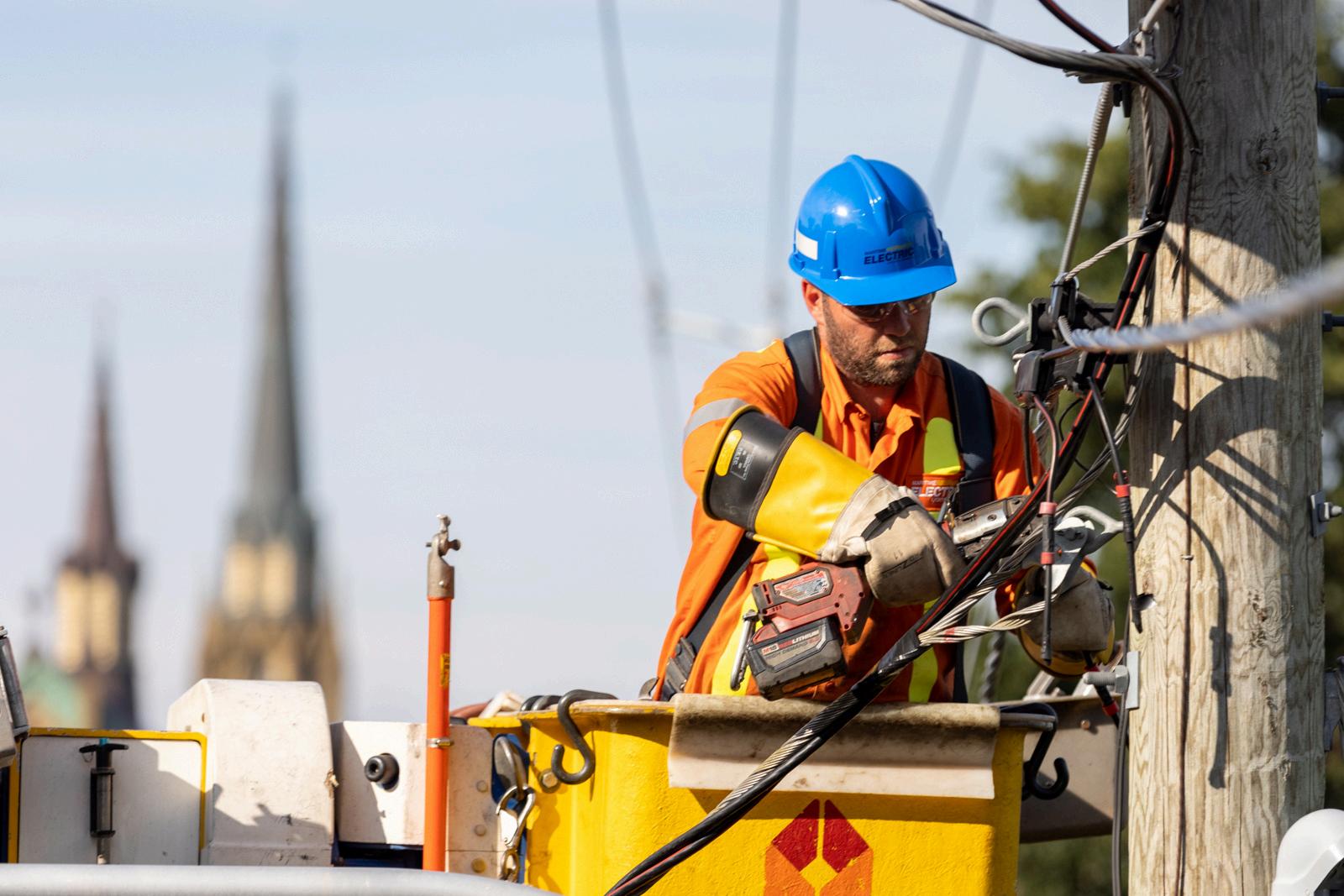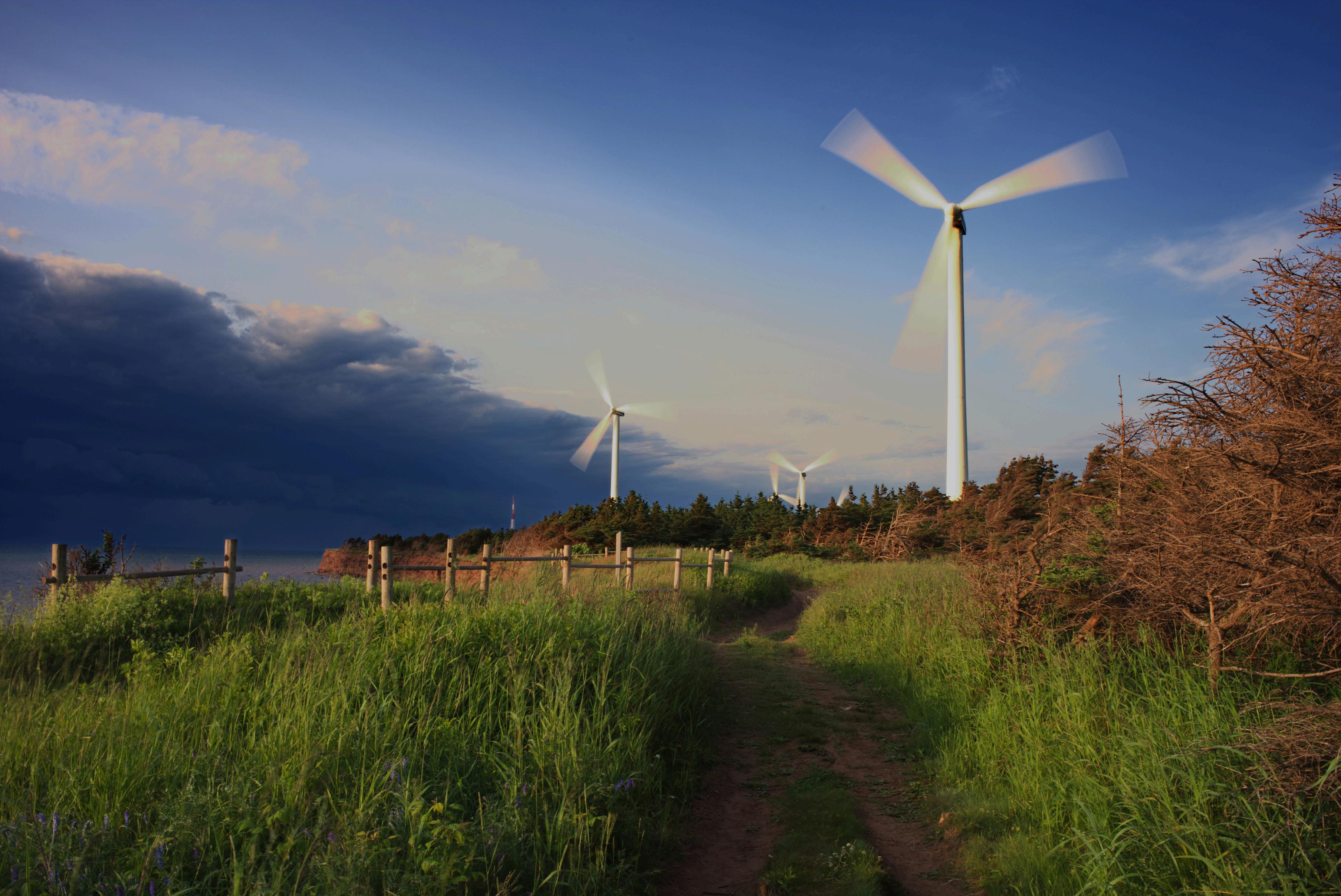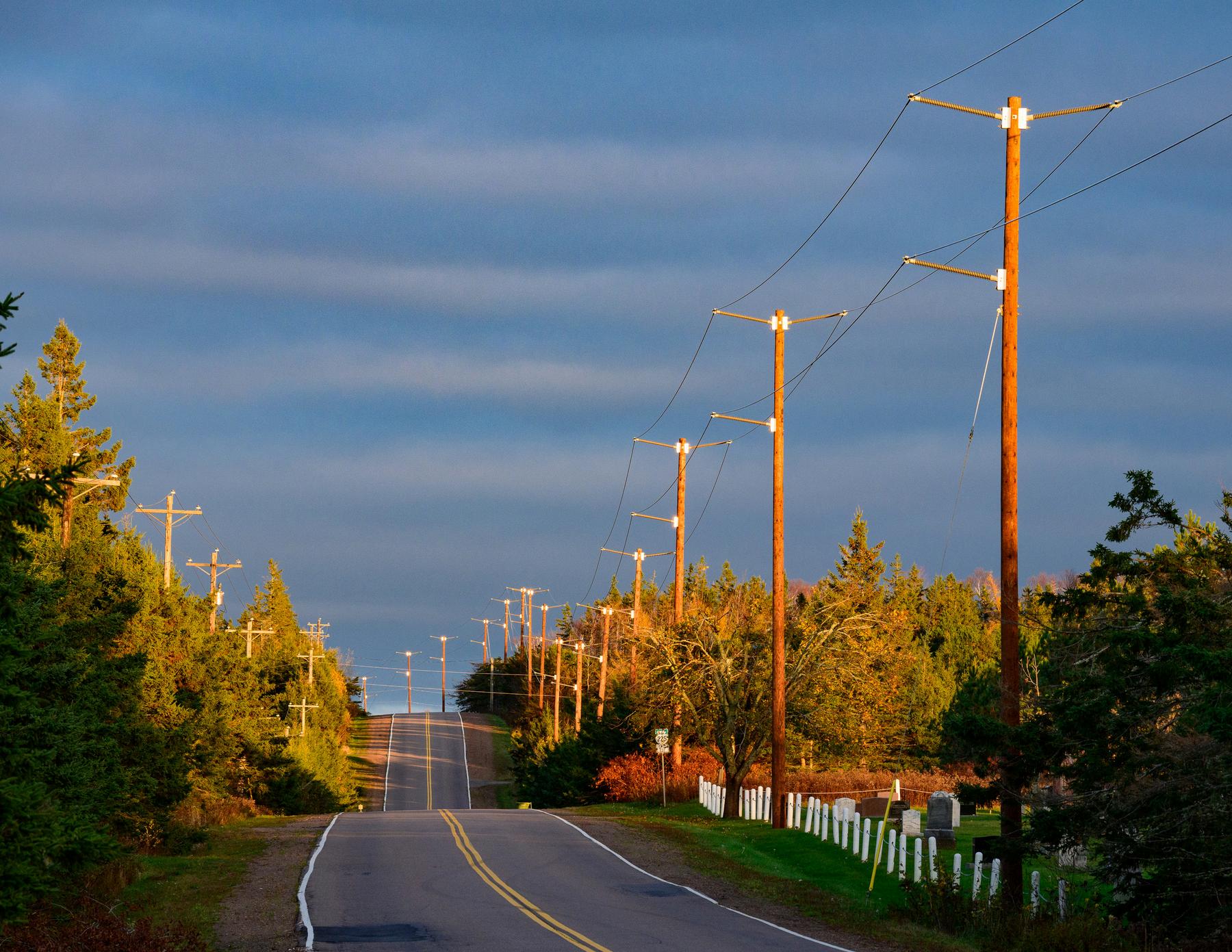
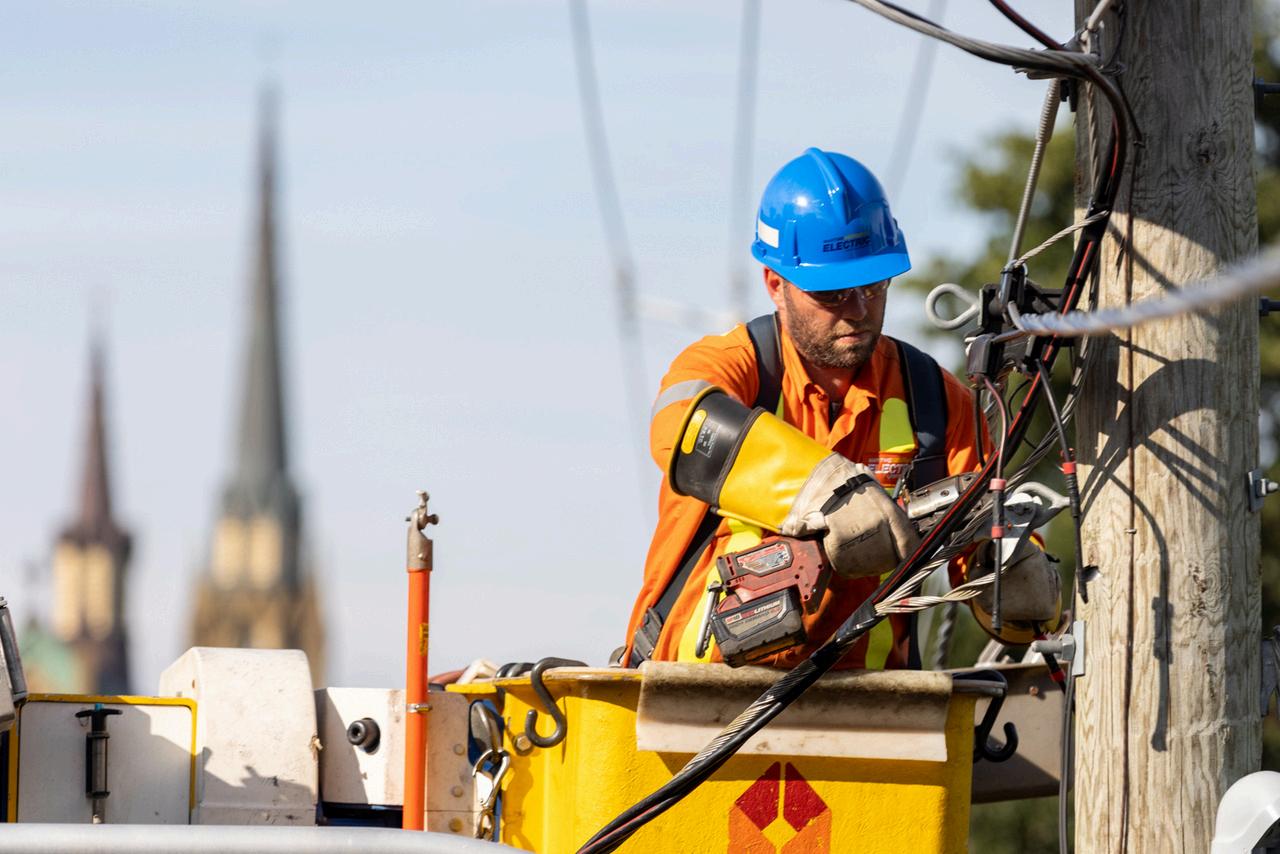

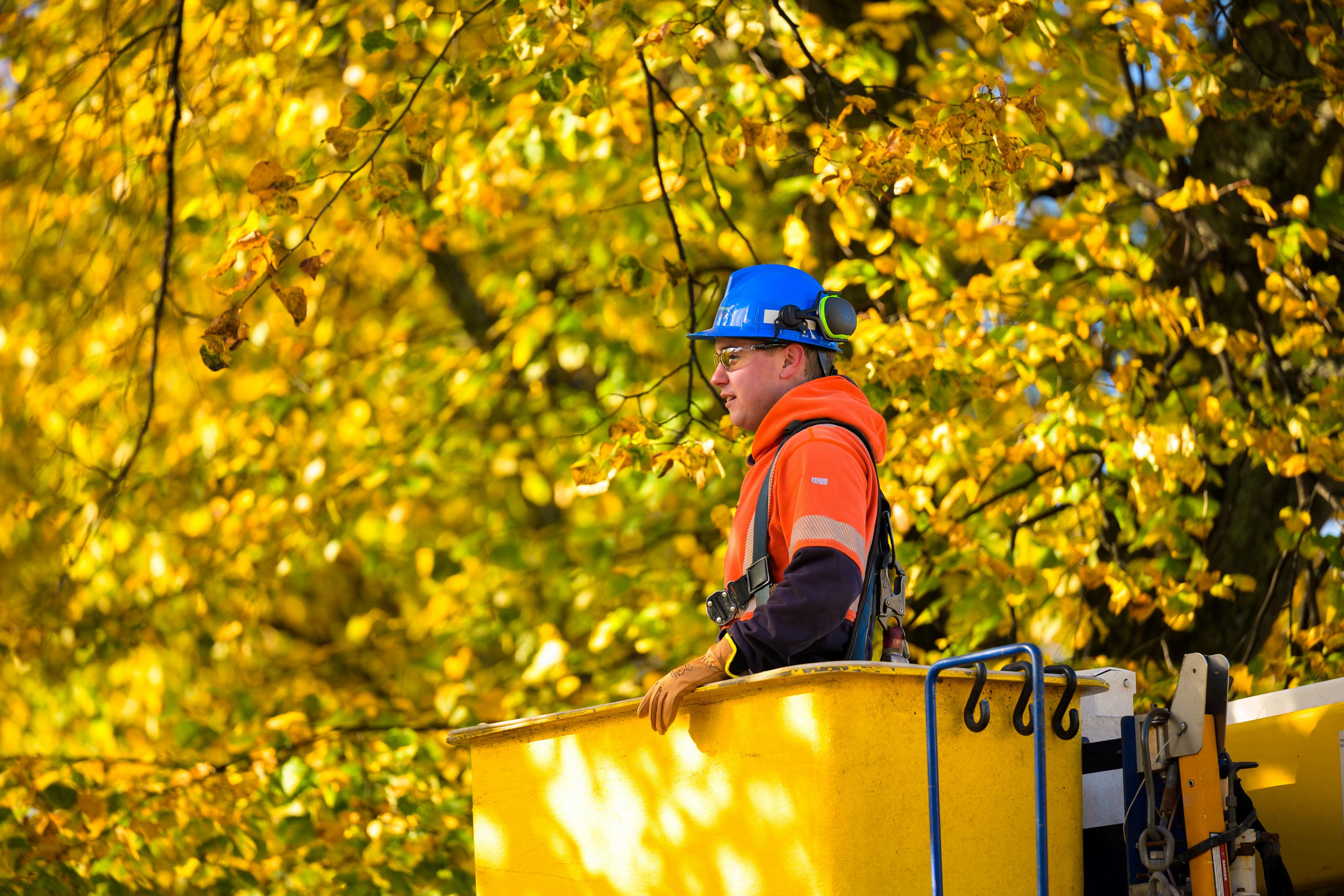

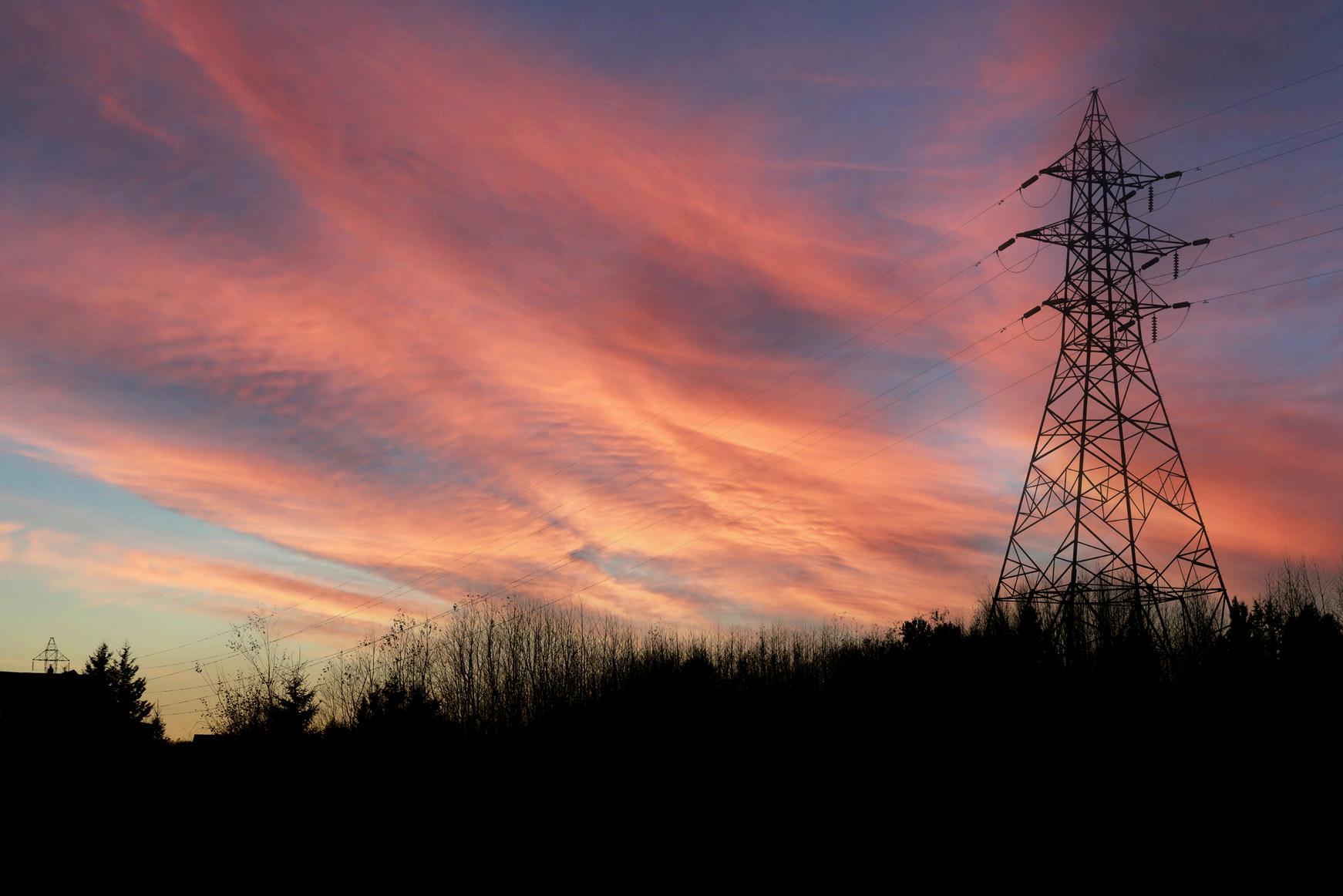

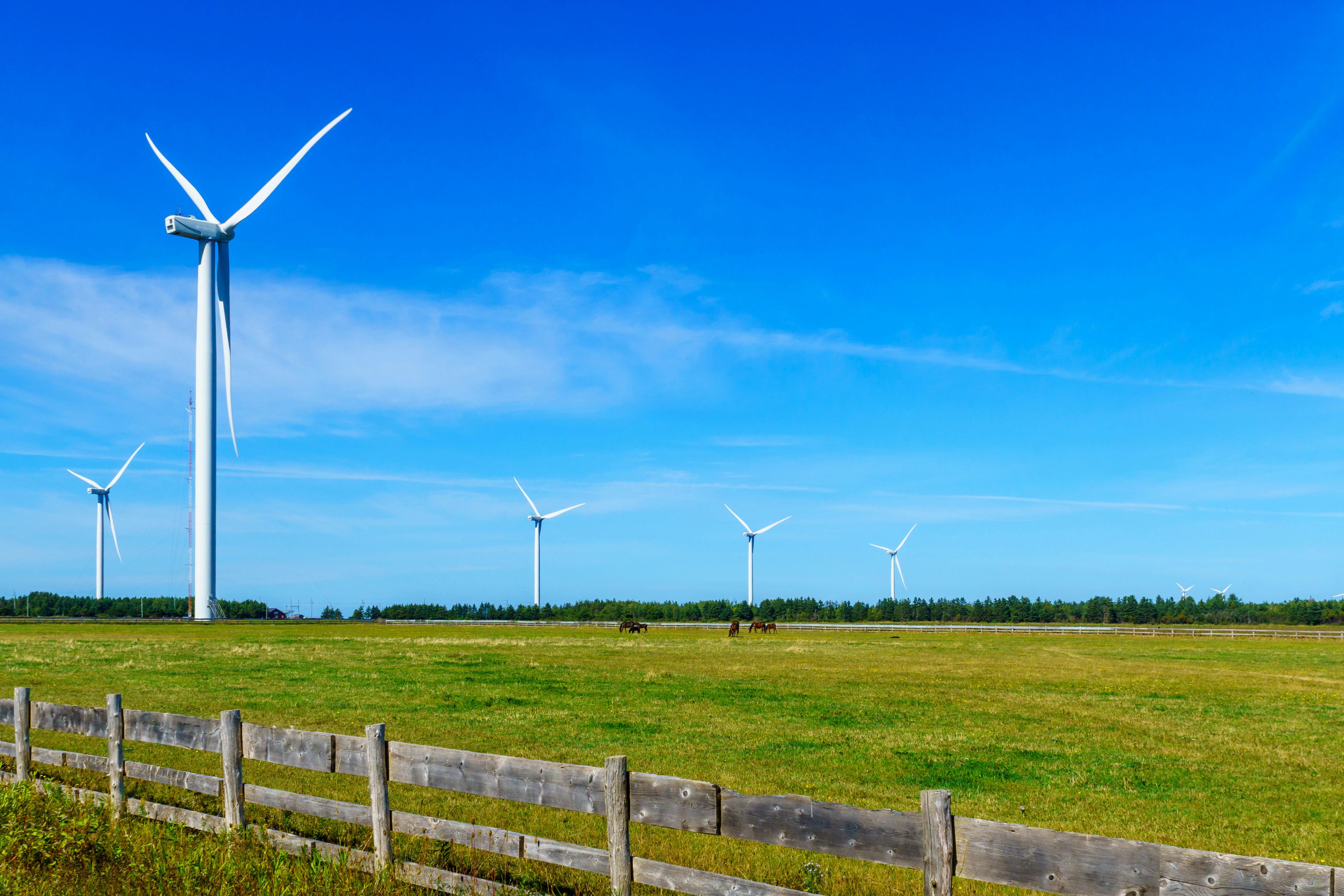


This report was made possible with financial support from the Government of Prince Edward Island’s Climate Challenge Fund











This report was made possible with financial support from the Government of Prince Edward Island’s Climate Challenge Fund
We respectfully acknowledge that the land upon which Maritime Electric operates is unceded Mi’kmaq territory. Epekwitk, Mi’kma’ki is covered by the historic Treaties of Peace and Friendship. We pay our respects to the Indigenous Mi’kmaq People, who have occupied this Island for over 12,000 years; past, present and future.
Corporate Spokesperson
Phone: 1-800-670-1012
Email: sustainability@maritimeelectric.com


Table
Table
Table
Table
Table
Table
Figure
Figure
Figure
Figure
Figure
Figure
Figure
Figure
Figure
Figure
Figure
Figure
Figure

Maritime Electric Company, Limited (“Maritime Electric”) is a fully integrated electric utility, owning and operating components of the electricity generation, transmission and distribution systems that serve over 89,000 customers across Prince Edward Island (“PEI”). Since 1918, Maritime Electric has served PEI’s energy needs with safe, reliable and increasingly cleaner electricity. In recent years, several extreme weather events, including Hurricane Dorian (2019) and Hurricane Fiona (2022), resulted in record-breaking impacts to Maritime Electric’s electrical infrastructure. The intensity and frequency of extreme weather events are expected to increase in the future due to climate change. Maritime Electric is committed to plan for and adapt to the changing regional climate to maintain reliable electricity service for customers.
After Hurricane Dorian impacted PEI in 2019, Maritime Electric began planning for climate change adaptation by assessing climate impacts, evaluating climate change projections, calculating climate change risks and developing adaptation strategies.
In 2022, Maritime Electric completed a Climate Change Risk Assessment (“Risk Assessment”). The Risk Assessment included the evaluation of climate hazards and their potential impact on Maritime Electric’s infrastructure, up to the year 2070. A summary of the high risks impacting Maritime Electric’s infrastructure is provided below:1
• Extreme minimum temperatures are associated with high risks to the combustion turbines.
• Extreme maximum temperatures are associated with high risks to transmission and distribution substation power equipment.
• Ice storm/freezing rain events are associated with high risks to overhead transmission and distribution lines, towers, and structures.
• Hurricanes and tropical storms are associated with high risks to overhead transmission lines on wood structures, transmission substation power equipment, overhead distribution lines and substation buildings, distribution substation power equipment, communication fibre systems, and the cable oil buildings in Richmond Cove and Murray Corner.
• Extratropical storms (e.g., Nor’easters) are associated with high risks to overhead transmission and distribution lines and structures, transmission substation power equipment, and the communication fibre system.
• Various climate hazards are associated with high risks to human resources.
This Climate Change Adaptation Strategy (“Adaptation Strategy”) report builds on the results of the Risk Assessment to further define, evaluate and prioritize climate change adaptation strategies. The Adaptation Strategy includes 17 strategies, which are categorized in four adaptation focus areas:
1 Stantec Consulting Ltd. 2022. PIEVC Assessment for Maritime Electric Company Ltd. Charlottetown: Maritime Electric Company, Ltd.

1. Design: infrastructure design or construction modifications to increase the ability to withstand the impacts of extreme weather events.
2. Operations: changes to operational practices that will help improve Maritime Electric’s effectiveness at identifying and resolving vulnerabilities to extreme weather events.
3. Resiliency: methods to reduce the impacts on customers from infrastructure damage following extreme weather events.
4. Employee Health and Safety: procedures to ensure the health and safety of Maritime Electric employees and contractors that are exposed to extreme weather events.
Maritime Electric developed and evaluated action items for each of the 17 adaptation strategies. Some of the adaptation strategies were successfully implemented in 2023, and others are ongoing or planned for the future. Maritime Electric’s Sustainability Department is responsible for monitoring and reporting on the implementation of the Adaptation Strategy and associated action items across Maritime Electric’s departments. The Adaptation Strategy requires continued review and updates as new climate science emerges and physical climate change risks are mitigated by Maritime Electric’s adaptation efforts.

Maritime Electric is a fully integrated electric utility, owning and operating components of the electricity generation, transmission and distribution systems that currently serve over 89,000 customers across PEI. Maritime Electric’s grid infrastructure includes 28 substations, three combustion turbine generators with a combined capacity of 90 megawatts (“MW”), over 6,600 kilometres (“kms”) of transmission and distribution lines, and over 127,000 utility poles. Maritime Electric also maintains and operates the four 138 kilovolt (“kV”) subsea cables that connect to New Brunswick, which are owned by the Government of PEI.
Since 1918, Maritime Electric has served PEI’s energy needs with safe, reliable and increasingly cleaner electricity. Maritime Electric is a subsidiary of Fortis Inc. (“Fortis”), a diversified holding company based in St. John’s, Newfoundland, and is regulated by the Island Regulatory and Appeals Commission (“IRAC”) operating under the provisions of the Electric Power Act and the Renewable Energy Act. Electricity is sourced from: imports from New Brunswick Electric Power Corporation (“NB Power”) through subsea cables between New Brunswick and PEI; Island wind and solar farms through contracts with the PEI Energy Corporation; Point Lepreau Nuclear Generating Station through a contractual entitlement with NB Power; small renewable energy generators through net metering agreements with customers; and Maritime Electric’s combustion turbine generators. The primary use of the combustion turbine generators is to supply energy in times of curtailment from off-island energy suppliers or during transmission line outages on PEI or on the mainland.
Maritime Electric’s approach to climate change includes mitigation and adaptation. Climate change mitigation tackles the causes of climate change directly by reducing the amount of GHG emissions, notably carbon dioxide, released into the atmosphere or by increasing the capacity to sequester atmospheric carbon dioxide. Climate change adaptation evaluates the future impacts of climate change and takes actions to reduce its impact towards human activities. In the electricity sector, mitigation means decreasing reliance on oil, natural gas, coal, and other fossil fuels for electricity generation, and adaptation means building a strong and resilient electrical grid that can withstand the impacts of climate change. Adaptation measures alone are not sufficient to manage climate change and must serve as a complement to mitigation efforts.
Climate change mitigation efforts have been underway at Maritime Electric’s Charlottetown Thermal Generating Station for the past decade. In 2022, Maritime Electric decommissioned the generating station, which eliminated the remaining on-Island heavy-fuel oil generating capacity and represents Maritime Electric’s most significant effort to date to reduce GHG emissions. Current Scope 1, Scope 2 and Scope 3 emission inventories and performance is verified by a third-party and published in Maritime Electric’s annual Sustainability Report.2 Maritime Electric’s target is to reduce GHG emissions by 55 per cent by
2 Maritime Electric’s annual Sustainability Reports are available at: maritimeelectric.com/sustainability

2030, compared to 2019 levels. Maritime Electric’s grid is already 85 per cent clean, but to reach the target Maritime Electric estimates that approximately 100 MW of additional wind energy and 120 MW of additional solar energy is required by 2030, compared to 2022 levels.3,4
After Hurricane Dorian impacted PEI in 2019, Maritime Electric initiated a Climate Change Risk Assessment to evaluate the long-term risks of climate change towards the electrical system. Maritime Electric received funding from the Government of PEI’s Climate Challenge Fund and engaged Stantec Consulting Ltd. (“Stantec”) to help complete the Risk Assessment, which studied current and future climate risks towards Maritime Electric’s infrastructure and identified potential climate change adaptation strategies. The Risk Assessment followed the Public Infrastructure Engineering Vulnerability Committee Protocol, an evidencebased approach to assessing climate change risks developed by Engineers Canada. The results of the assessment demonstrate that risks associated with extreme climate events will increase in the future, and that climate change adaptation is required to manage these risks. Also included in the report were potential preliminary adaptation strategies for the high risks identified, each of which varies in complexity and cost.
In 2023, Maritime Electric received additional funding through the Government of PEI’s Climate Challenge Fund to complete this Adaptation Strategy.
3 85 per cent clean electricity is based on 2022 data.
4 Other combinations of wind and solar are also possible.

Maritime Electric’s climate change adaptation approach follows a four-step process, as shown in Figure 1. Steps 1 to 3 were completed in 2022 as part of Maritime Electric’s Risk Assessment and Step 4 consists of this Adaptation Strategy report. Maritime Electric intends to repeat the four-step process approximately every five years to re-evaluate climate change risks as new climate data and information becomes available. The four-step process is described in more detail as follows.
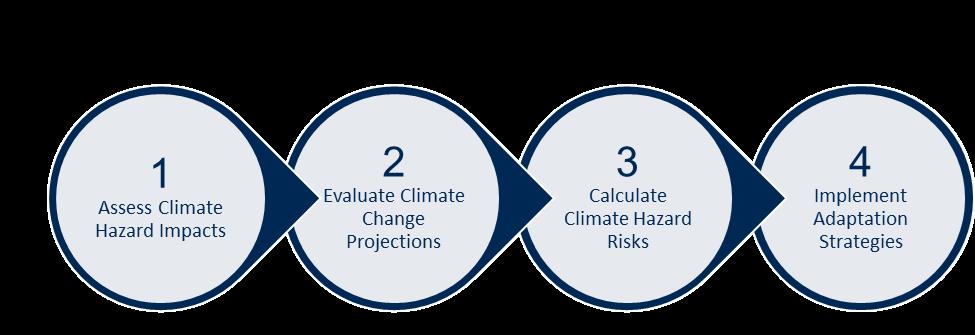
Infrastructure Identification
Identify infrastructure owned by Maritime Electric to be evaluated in the risk assessment such as transmission and distribution lines, substations, combustion turbines and select buildings. Identify infrastructure owned by third parties that could impact Maritime Electric’s operations such as the four subsea cables and associated equipment, transmission lines and equipment from Memramcook to Murray Corner and Cape Tormentine that supply the subsea cables, and on-Island wind and solar farms. Include human resource personnel and contractors as part of the evaluation.
A map of Maritime Electric’s service territory and significant infrastructure identified in the 2022 Risk Assessment is shown in Figure 2.5
5 Infrastructure located in New Brunswick and owned by NB Power is not shown.

6
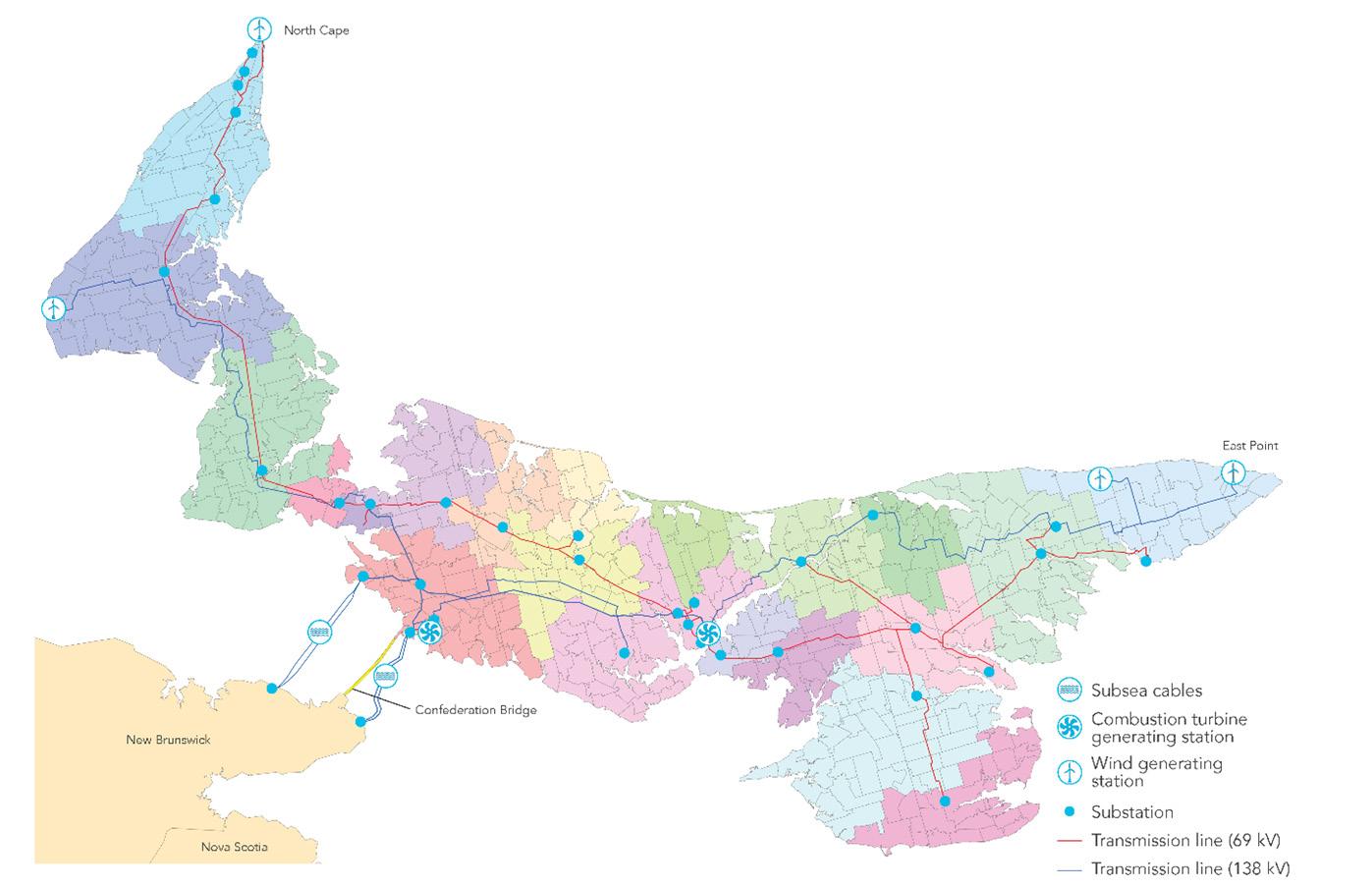
Evaluate the potential impacts (i.e., consequence) of several climate hazards towards the identified infrastructure by utilizing criteria aligned with Maritime Electric’s Enterprise Risk Management Framework. The categories used in the 2022 Risk Assessment to assess the impact of climate hazards included:6
• Physical System Effects: physical disruptions to transmission, distribution, or other assets.
• Operations and Maintenance Deployment: personnel and/or resources required to address disruptions to operations.
• Load Restoration: the time required to restore electrical service to customers during an outage event.
• Financial Loss: restoration costs to address consequence (e.g., cost of asset repair or replacement).
• Health and Safety of Personnel: reduced work capacity or injuries related to climate events.
The consequence of climate hazards was scored based on the consequence scoring criteria shown in Table 1.

1 Very Low Routine day-to-day trouble
2 Low
3 Moderate
Multiple power lines and facilities affected
Impacts can be managed by Energy Control Centre (ECC) and available Customer Service Utility Persons
Impacts can be managed with available resources (i.e., personnel, material and equipment). Customer Service Representatives (“CSRs”) may be required. Personnel overtime may be required.
Restoration of affected load generally within 3 hours
<$100,000 Routine operations
Restoration of affected loads more than 3 hours and up to 24 hours
Multiple power lines and facilities affected possibly including transmission lines
4 High
5 Very High
Multiple power lines and facilities affected including transmission lines or substations. Possible rolling blackouts.
Multiple power lines and facilities affected including multiple transmission lines or multiple substations. Possible loss of equipment with long lead times. Possible island-wide blackout.
Additional Maritime Electric resources and/ or local contractors required. CSRs required. Combustion turbine operators may be required. Personnel overtime required.
All Maritime Electric resources and local contractors utilized. CSRs required. Combustion turbine operators required. Extensive personnel overtime required.
All Maritime Electric resources and local contractors utilized, and off-island contractors (mutual aid) required. CSRs required. Combustion turbine operators required. Extensive personnel overtime required.
Restoration of affected loads more than 24 hours and up to 3 days
$100,000$300,000
$300,000$500,000
Potential for minor injury (e.g., dehydration, sprained joints/strained muscles)
Potential for moderate injury (e.g., heat exhaustion, broken bone, frost bite)
Restoration of affected loads more than 3 days and up to 7 days
$500,000$1,000,000
Potential for major injury (e.g., heat stroke, loss of limb)
Loads not restored within 7 days
>$1,000,000
Potential for loss of life

Identify future climate conditions (i.e., projections) for each climate hazard including temperature, precipitation, wind and other complex climate hazards, to determine the probability of occurrence within different regions. As part of the 2022 Risk Assessment, Stantec developed climate projections using downscaled Global Climate Models. Climate projections were based on the Intergovernmental Panel on Climate Change’s Representative Concentration Pathway (“RCP”) 8.5 and RCP 4.5 up to the 2070s period.8 RCP 8.5 was used for the risk analysis because it is the most widely used RCP for climate change risk assessments and represents the potential worst-case scenario. Climate projections were completed for Western, Central and Eastern PEI, as well as Northeastern New Brunswick for NB Power infrastructure; however, the results did not show material differences in climate projections between the regions.
Evaluate the climate change projections using a probability scale. The scale used for the 2022 Risk Assessment is shown in Table 2.

Risk Assessment
Combine the probability scores of each projection with the consequence scores for infrastructure impacts to calculate overall climate change risk rankings for each climate hazard, categorized as low, medium or high. The risk matrix used in the 2022 Risk Assessment is shown in Table 3.
Table 3: Risk Matrix for the Climate Change Risk Assessment10
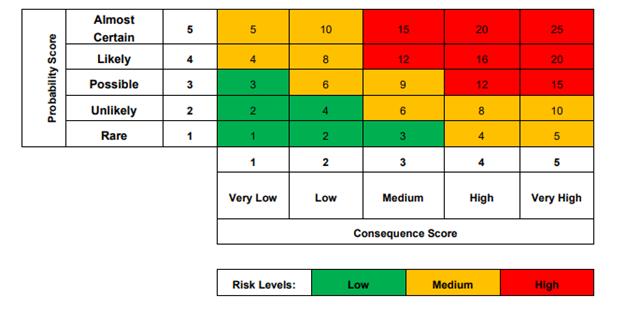
Results
The 2022 Risk Assessment identified several climate hazards that pose a high risk to Maritime Electric’s infrastructure and human resources, including changes in temperature, precipitation, high wind, ice storms, hurricanes and extratropical storms. Various climate hazards in New Brunswick including ice storms, freezing rain, hurricanes, extratropical storms, and lightning were also identified as posing high risks to Maritime Electric. A summary of the 2022 Risk Assessment results is shown in Table 4.

Climate Hazards
High daily average temperature

Extreme maximum temperature
Heat waves
Extreme minimum temperature





Freeze-thaw cycles
High winds



Hurricanes

Extratropical storms

Maritime
• High risks towards human resources working outdoors (e.g., dehydration and heat stroke)
• High risks towards substation power equipment that requires cooling (e.g., transformers)
• High risks towards human resources working outdoors (e.g., dehydration and heat stroke)
• High risks towards human resources working outdoors (e.g., dehydration and heat stroke)
• High risks towards combustion turbines required to operate during cold temperatures
• High risks towards human resources working outdoors (e.g., frost bite)
• No high risks identified
• Medium risks towards infrastructure with concrete foundations
• High risks towards overhead transmission, distribution and fibre communication lines for gusts above 130 km/h
• High risks towards overhead transmission, distribution and fibre communication lines
• High risks towards substation power equipment and buildings
• High risks towards New Brunswick corridor infrastructure
• High risks towards human resources working outdoors
• High risks towards overhead transmission, distribution and fibre communication lines
• High risks towards substation power equipment and buildings
• High risks towards New Brunswick corridor infrastructure
• High risks towards human resources working outdoors
• No high risks identified due to low probability
Tornadoes

• Medium risks identified towards infrastructure and human resources (see list above for hurricanes)



Sea level rise

Storm surge
Lightning
Extreme rainfall

Ice storms
Heavy snowfall


Tree growth
Wildfires







• No high risks identified
• Medium risks towards infrastructure near the coast
• No high risks identified
• Medium risks towards the Charlottetown Generating Station substation and infrastructure accessibility near the coast
• High risks towards New Brunswick corridor infrastructure
• High risks towards human resources working on the electrical system
• No high risks identified
• Medium risks towards underground infrastructure (e.g., underground vaults and chambers)
• High risks towards overhead transmission and distribution lines
• High risks towards New Brunswick corridor infrastructure
• High risks towards human resources due to poor driving conditions
• No high risks identified
• Medium risks towards human resources due to driving conditions
• Tree growth rates are expected to increase due to increased temperatures and humidity, longer growing seasons and increased precipitation
• No high risks identified due to low probability
• Medium risks towards overhead infrastructure and substations in densely wooded areas

As part of the 2022 Risk Assessment, Maritime Electric identified several preliminary adaptation options for infrastructure that had high climate change risk scores. Since then, Maritime Electric has further refined and developed climate change adaptation strategies, which are included in the Adaptation Strategy. Maritime Electric focused on adaptation strategies that have the most potential to reduce climate change risks at a reasonable cost. The adaptation strategies are categorized based on four focus areas:
1. Design: infrastructure design or construction modifications to increase its ability to withstand the impacts of extreme weather events.
2. Operations: changes to operational practices that will help improve Maritime Electric’s effectiveness at identifying and resolving vulnerabilities to extreme weather events.
3. Resiliency: methods to reduce the impacts towards customers of infrastructure damage following extreme weather events.
4. Employee Health and Safety: procedures to ensure the health and safety of Maritime Electric employees that are exposed to extreme weather events.
Maritime Electric will implement the adaptation strategies highlighted in this report through its existing planning and budgeting processes to support regulatory filings, which will require approval from IRAC. Maritime Electric’s Sustainability Department is responsible for monitoring and reporting on the implementation of the adaptation strategies and associated action items. As adaptation strategies are implemented and the local climate changes, Maritime Electric will continue to monitor progress on completing adaptation strategies and their impact on reducing climate change risks. Maritime Electric intends to update its Risk Assessment, at a minimum, every five years to update climate change projections and impacts based on adaptation efforts completed.

This section provides details regarding Maritime Electric’s 17 adaptation strategies, which are categorized in four focus areas:
1. Design: infrastructure design or construction modifications to increase its ability to withstand the impacts of extreme weather events.
2. Operations: changes to operational practices that will help improve Maritime Electric’s effectiveness at identifying and resolving vulnerabilities to extreme weather events.
3. Resiliency: methods to reduce the impacts towards customers of infrastructure damage following extreme weather events.
4. Employee Health and Safety: procedures to ensure the health and safety of Maritime Electric employees that are exposed to extreme weather events.
Each adaptation strategy contains one or more action items, which are categorized based on progress as follows:
• Planned: actions that are pending regulatory approval or are planned for the future.
• Ongoing: actions that are continuously being applied.
• In progress: actions that are in progress for completion.
• Complete: actions that were identified in the Risk Assessment and since completed.
Overhead line design is a critical aspect of the electrical distribution and transmission system. The effective planning, construction, and maintenance of overhead lines are essential for ensuring the reliable and safe delivery of electricity to customers. To achieve this, industry professionals adhere to comprehensive design standards and construction methods that encompass the entire expected useful life of overhead lines.
Action 1.1
Update overhead line design standards to reflect projected changes in the local climate (in progress)
Overhead line design standards consist of guidelines and specifications that engineers follow to ensure the infrastructure’s quality, reliability, and safety. Design standards encompass elements such as conductor selection, structure design, insulating requirements, line clearance requirements and environmental considerations. Maritime Electric meets all required Canadian Standards Association (“CSA”) standards related to line design and exceeds CSA standards for structure strength and clearances to ensure a robust

system.12 CSA’s approach involves providing data that is geographically specific, acknowledging the diverse climate challenges faced by provinces, territories, and communities. However, CSA data is based on historical climate and does not necessarily consider local climate change impacts. Recently, CSA began encouraging electric utilities to design infrastructure based on local historical weather and projected climate change impacts. With the projected changes in the local climate, Maritime Electric is updating weather criteria and design standards to account for climate change projections within PEI’s geographical region.
Maritime Electric uses PLS-CADD, a line design software from Power Line Systems, to design new lines and analyze existing ones. PLS-CADD uses non-linear design analysis, as required by CSA standards, for overhead line design. The software also integrates geospatial information, which enables users to work with current terrain data and ensures accurate modeling of overhead line routes. The software’s 3D visualization capabilities enable engineers to visually assess transmission line designs on the landscape and identify potential limitations within a specific geographical area. PLS-CADD performs a range of engineering calculations, including sag and tension analysis, structural analysis of towers and poles, and clearance analysis to ensure line design and construction comply with safety standards and regulations. The software also simulates unique scenarios, such as broken wire scenarios, to ensure that structures are stable in the event of a failure. The design load and structural analyses consider factors such as wind, ice, temperature, conductor tension and more to ensure that overhead lines and structures can withstand forces produced by various environmental conditions.
In 2023, following the completion of the Risk Assessment, Maritime Electric engaged Stantec to provide detailed climate probability data. The data is being used to update Maritime Electric’s climate parameters and criteria files for overhead line design standards using an evidence-based approach. The climate probability projections used to update Maritime Electric’s climate parameters are provided in Appendix A: Stantec Climate Data. Given that the majority of Maritime Electric’s infrastructure has an expected useful life of 50 years, Maritime Electric intends to use the 2070 1-in-50-year probability climate parameters to update its weather criteria and line design standards for new construction. Maritime Electric’s intention is to update climate projections every five years and update climate design parameters accordingly.13 A comparison of CSA standards and Maritime Electric’s existing and updated climate parameters for weather modeling scenarios are shown in Table 5; weather parameters that have changed are shown in red.
12 CSA Standard C22.3 No. 1:20 Overhead Systems
13 The 2070 1-in-50-year climate parameters represent what is predicted to be a 1-in-50-year climate event in the 2070s. The probability of such an event occurring in the present day is lower than 1-in-50 years.

Table 5: Comparison of Existing and Proposed Modeling Scenarios and Weather Parameters
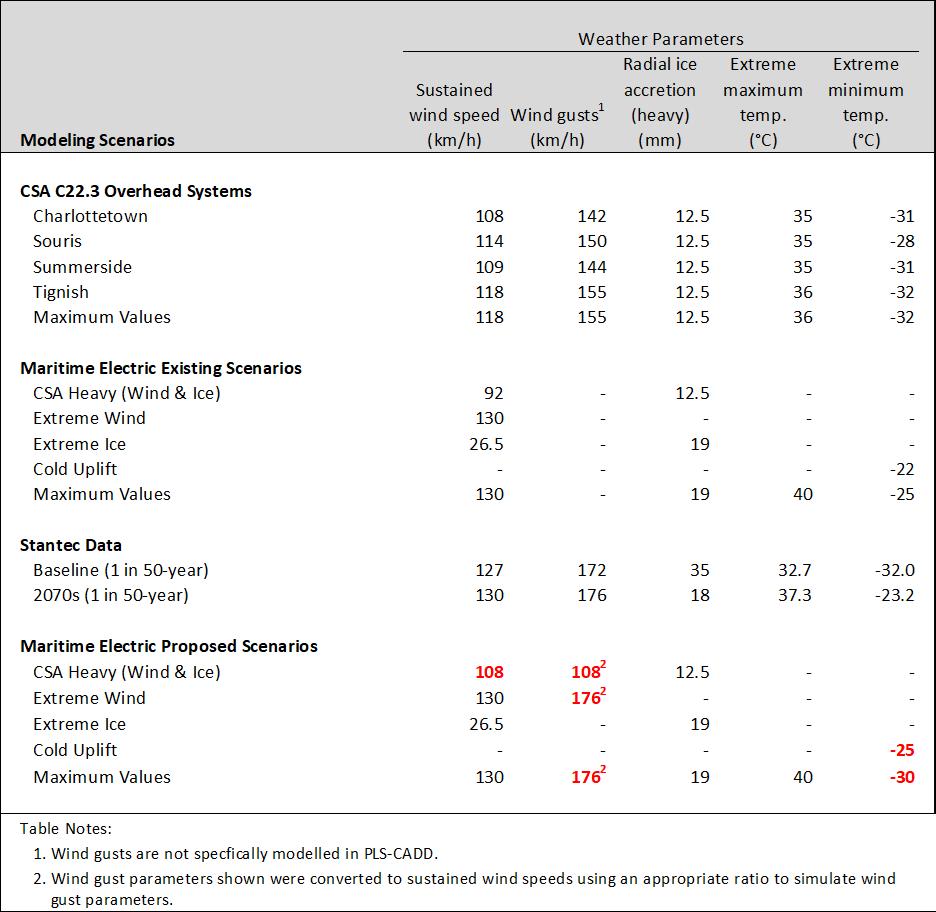
Action 1.2 Implement strategic line design standards to mitigate the risk of cascading transmission structures (planned)
Maritime Electric’s transmission system, as shown in Figure 3, is composed of over 8,900 wooden or steel structures and over 750 kms of transmission lines. The transmission system interconnects and provides electrical supply to substations, where voltage is reduced for widespread distribution to customers. Damage assessment following Hurricane Fiona identified a significant number of trees that fell on transmission lines; however, only 10 transmission structures were damaged and required replacement. While Maritime Electric’s transmission infrastructure suffered only minimal damage during Hurricane Fiona, outages on

transmission lines can result in the loss of service to one or more substations, which deliver electricity to thousands of customers; therefore, the prevention of transmission-related outages is essential.
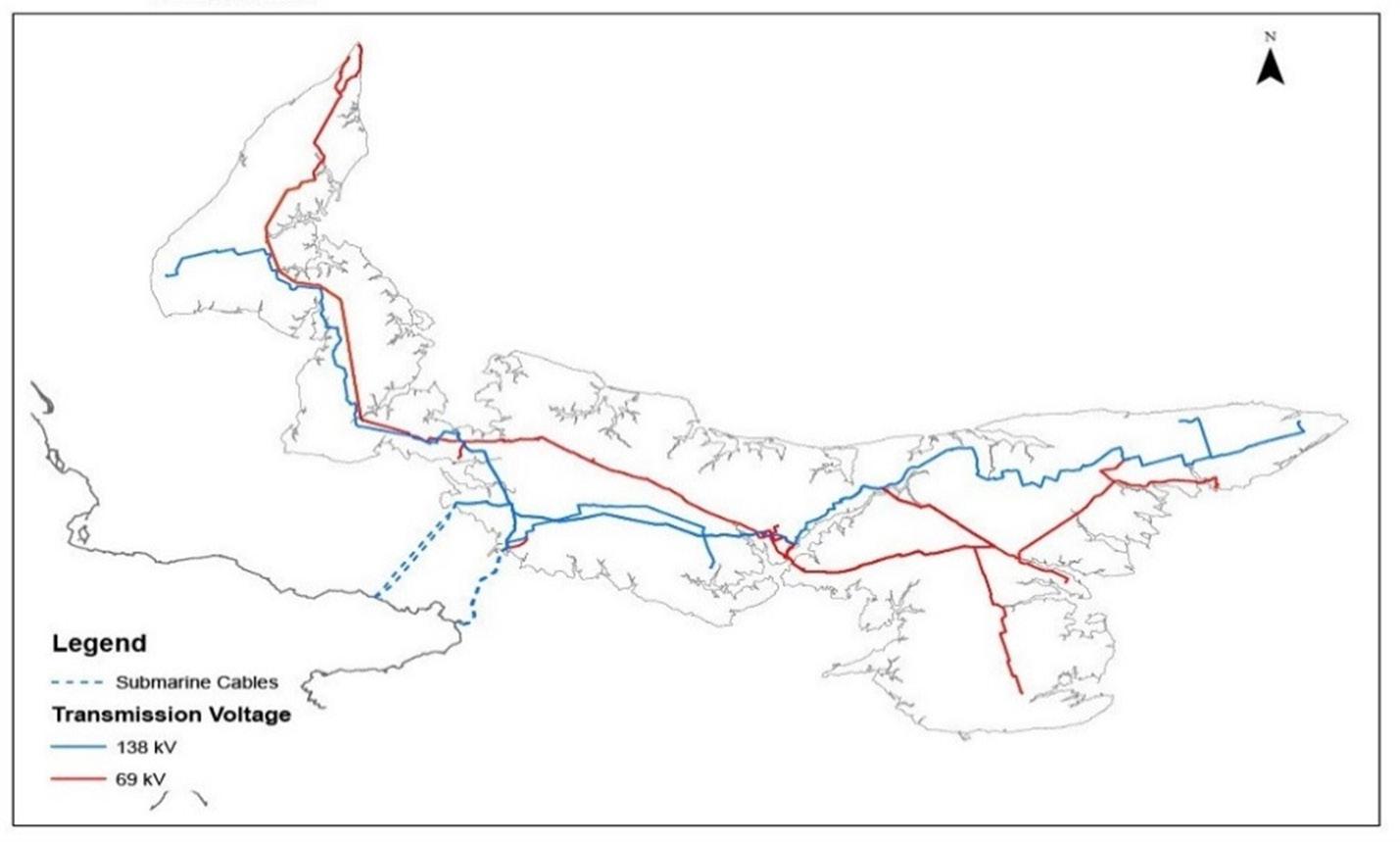
Preventing cascading failures of transmission structures can be accomplished by installing additional guys and anchors to existing lines, a practice known as “storm guying.”14,15 Traditionally, guys and anchors are installed to support offset loads or angled structures, which stabilizes transmission and distribution structures. However, storm guying adds additional support to existing structures to significantly increase their resistance to dynamic loads from multiple directions and reduce the risk of cascading transmission structure failures. For basic structures, up to four additional guys can be installed, and for more complex structures, such as dead-ends and vertically framed structures, up to 12 guys may be required. An example of storm guying on one of Maritime Electric’s transmission structures is shown in Figure 4.
14 Cascading refers to the failure of multiple structures in a sequence, where the failure of a single structure causes successive structures to fail.
15 Guys are tensioned wires that anchor the top of a structure to the nearby ground at an angle.

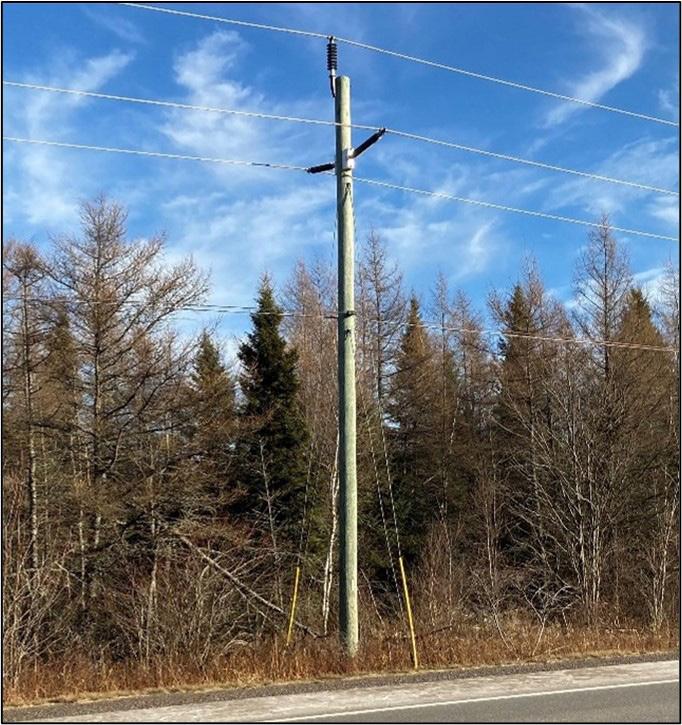
Another method that can prevent cascading impacts for transmission structure failures is to identify strategic locations on the transmission system to implement more robust line design standards. For example, the risk of cascading transmission structure failures can be reduced by adding double-dead-end structures, as opposed to tangent structures, at targeted locations.16 Double-dead-end structures, as shown in Figure 5, include additional guying and anchoring, which helps stabilize and anchor the transmission line in the event of a cascading scenario. Examples of locations that may be targeted to reduce the risk of cascading impacts include:
• Line sections located in heavily treed areas;
• Line sections in areas that are commonly exposed to high wind; and
• Line sections with a significant number of consecutive tangent or light-angle structures.
A detailed analysis of the transmission system will be completed to identify transmission structures to implement strategic storm guying and more robust line design standards.
16 Tangent structures are poles sequenced in a straight line with minimal to no line angle. Double-dead-end structures are poles where a line turns at a large angle.

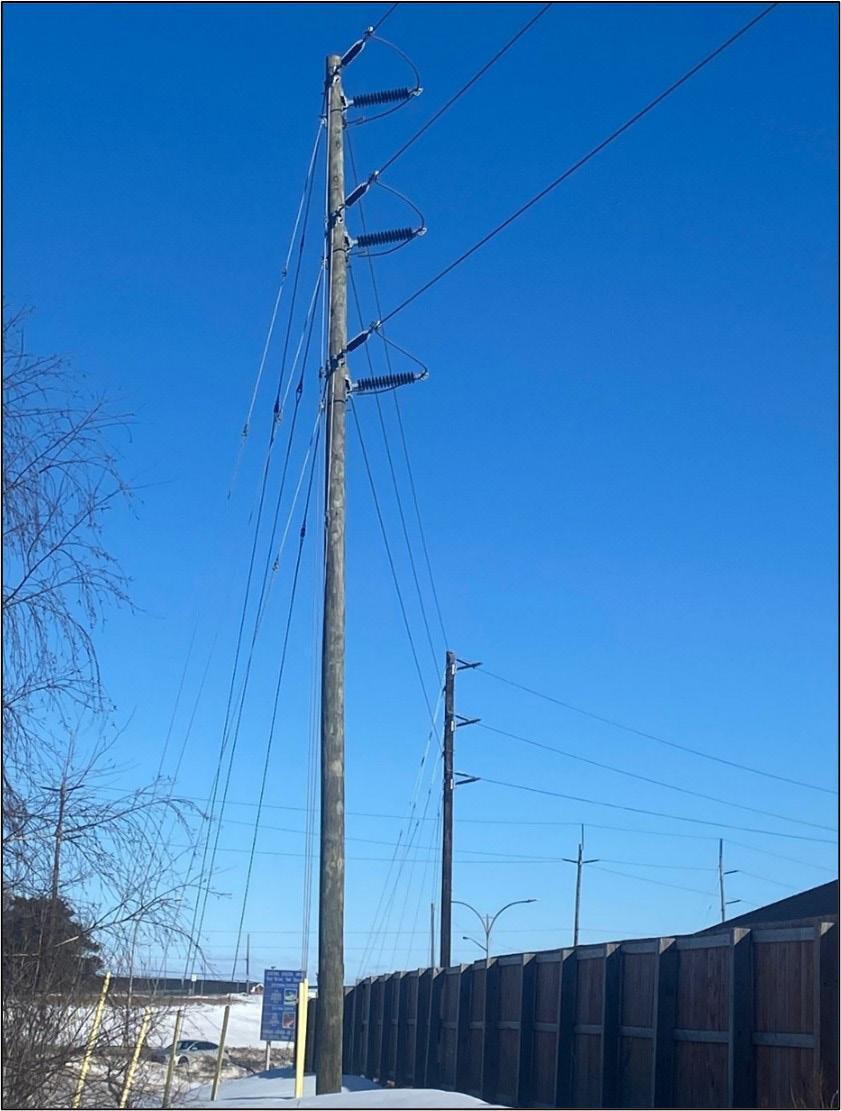
Action 1.3 Consider the use of more resilient pole structure materials in strategic areas (ongoing)
Maritime Electric and other electric utilities in Canada use primarily wood poles for their electrical system. Wood poles are sourced locally in Canada and are less expensive compared to other pole types, such as steel and composite poles. Poles are available in various heights and classes, depending on the application.17 Pole height requirements are determined by CSA standards and based on the type of line, clearance requirements by voltage and the number of attachments on the pole (e.g., communication lines). Maritime Electric uses industry best practices and specialized line design software to determine the type, height and class of poles used throughout its electrical system.
Maritime Electric uses steel poles in some cases, such as river crossings, where wood poles cannot be installed. For example, transmission line T-2 utilizes steel poles along the Hillsborough Bridge between Charlottetown and Stratford. Steel poles can be stronger than wood poles but are more expensive and

less versatile. Additionally, adding lines and attachments is more complex and performing live line work is more challenging for steel poles compared to wood poles.
Wood poles are recognized as more environmentally friendly than other pole materials. A literature review conducted in 2017 of studies that performed life cycle assessments for various utility pole materials showed that wood poles typically have lower environmental impacts compared to other materials.18 The literature review also showed variations in the useful life of poles amongst the 13 studies reviewed, but the majority assigned a consistent useful life of 50 to 60 years for wood, steel and composite pole materials. The literature review does not clearly demonstrate that a specific pole material has superior durability over others.
Maritime Electric will continue to follow CSA standards and use line design software to determine the appropriate pole material, size and class for various applications. The climate change data and line design software discussed in Action 1.1 will determine whether more steel or composite poles are used in certain applications based on the criticality of the line.
Action 1.4 Consider the use of more resilient pole structure materials in strategic areas (ongoing)
Galloping is a naturally occurring phenomenon caused by the combination of ice formation on conductors and moderately strong crosswind.19 Galloping generally occurs when steady perpendicular crosswind with low turbulence causes high amplitude vertical conductor oscillations; therefore, river crossings or areas near the shore with open exposure are more susceptible to galloping.20 Frequent galloping for extended periods of time can weaken pole structures and conductor connections. In some instances, galloping can result in arcing between conductors and faults for three-phase lines.21
According to an Electric Power Research Institute research project conducted in 2005, there are three main methods to reduce the risk of galloping: ice removal, making lines tolerant to galloping and installing mechanisms that interfere with galloping.19
18 Nimpa, G. D., J. M. Njankouo, P. S. Ngohe-Ekam, and T. Tamo Tatiestse. 2017. “Life Cycle Assessment of Power Utility Poles – A Review.” International Journal of Engineering Science Invention 6 (2): 16-32.
19 Task Force B2.11.06. n.d. “State of the Art of Conductor Galloping: A Complementary Document to “Transmission Line Reference Book –WindInduced Conductor Motion Chapter 4: Conductor galloping,” Based on EPRI Research project 792.”
20 Havard, D. G. 2007. Conductor Galloping: A Tutorial Presented at the IEEE ESMOL and TP&C Meeting. Las Vegas, January.
21 Three-phase lines contain three conductors, each of which is referred to as a phase.

Removing ice from lines consists of de-energizing lines to physically remove the ice. Methods associated with removing ice are generally not practical because they require line outages, which can impact customers. Additionally, extreme galloping is typically not identified until after damage or a fault occurs.
Making lines tolerant to galloping includes designing lines to mitigate the impacts of galloping. Examples include shorter spans and increasing the strength of pole structures. Allowing for proper line clearances between phases can also prevent faults caused by galloping. Currently, Maritime Electric includes a CSA galloping scenario when performing design load analyses for new lines, which ensures lines can withstand the impacts of moderate galloping; however, extreme galloping or frequent galloping in the same area can cause fatigue failure on pole structures and components over time.
Adding mechanisms that interfere with galloping consists of adding physical devices to new or existing lines. Cost-effective solutions for adding physical devices to lines to prevent galloping exist, such as airflow spoilers, that can interfere with the forces that cause galloping, thus reducing its amplitude and impacts. Air-flow spoilers, as shown in Figure 6, are helical devices widely used in the industry that attach to new or existing lines and change the aerodynamic profile of the line. The change in aerodynamic profile across the line interferes with the formation of ice surface formations that result in galloping. Currently, Maritime Electric successfully uses air-flow spoilers in some areas that are prone to galloping, such as on its transmission line T-2 along the Hillsborough Bridge between Charlottetown and Stratford and other river crossings.

Predicting where galloping will occur in advance is difficult because the phenomenon is impacted by several factors and is a function of the natural frequencies of the wire in the application; therefore, Maritime Electric will continue installing galloping prevention devices in areas where galloping is frequently observed. River crossings, for example, are more prone to galloping due to potential high crosswinds and long spans between poles.
22 Kuiper, Jason. 2020. How does that work? Air-flow spoilers. December 28. https://oppdthewire.com/air-flow-spoilers-how-works/

Action 1.5
Evaluate the strategic use of break-away devices for service lines (planned)
During Hurricane Fiona, over 2,000 Maritime Electric customers experienced damaged service masts.23 Damage to service lines and masts is typically last to be repaired during major restoration events, as crews work to prioritize repairs to transmission and main distribution lines.24 Damage to service lines and customer-owned service masts attached to buildings require a certified electrician to make repairs, which can further delay power restoration to the customer. A relatively new method of avoiding damage to service lines and service masts is to use break-away devices.
Break-away devices are components that attach to a power line and serve as a mechanical break-away point to separate the secondary line at the pole connection in the event that a tree falls on the line. Breakaway devices can prevent damage to customer-owned service masts and reduce the risk of broken service lines. In the event that a tree falls on a service line, a break-away device would disconnect from the pole and fall to the ground. Using break-away devices for service lines has the following benefits:
• Service lines are disconnected at the pole, which safely de-energizes the service line before it falls;
• Break-away devices facilitate work for crews when manually disconnecting damaged service lines and opening cutouts to make service lines safe for tree removal by customers and prior to energizing main distribution lines; and
• Break-away devices utilize a quick-connect system, which may reduce the time required to reconnect customers.
Break-away devices are relatively new to the electric utility industry; therefore, their long-term effectiveness remains unknown. Maritime Electric is in the process of selecting break-away devices to test on service lines. The devices will be tested for their ease of installation and their effectiveness against minimizing damage to service lines and customer-owned service masts.
Maritime Electric’s transmission and distribution system consists of both overhead and underground lines, with the vast majority of the system consisting of overhead lines. Underground distribution lines are typically limited to urban areas to maintain clearances and for visual aesthetic purposes, whereas underground transmission lines are typically limited to substation duct banks. Maritime Electric permits its customers to supply and install their own underground secondary service, and Maritime Electric’s personnel connect it to its facilities for energization. In new developments, such as new subdivisions, developers may choose to pay for the installation of underground primary lines, and customers can choose to install underground services from the underground primary lines.
The benefits of underground power lines include improved system reliability, improved visual aesthetic and reduced vegetation management requirements; however, underground power lines are significantly more expensive than overhead lines. Underground power lines can also have longer restoration times if
24

outages occur, are difficult to inspect, require outages when connecting new customers, are more difficult to upgrade for load growth and can be prone to flooding in coastal or low-lying areas. Additionally, communication line requirements can complicate the process of installing power lines underground because coordination is required with communication service providers during construction. For these reasons, installing power lines underground is not always a preferred solution to mitigate climate change risks, and should instead be considered on a case-by-case basis.
Action 2.1
Develop a program to encourage the installation of underground service lines for customers (planned)
Currently, underground service lines are available as an optional facility as per Maritime Electric’s Rates and General Rules and Regulations (“Rules and Regulations”). Customers can choose to install underground service lines, but the majority of customers select overhead service lines due to the prohibitive cost of burying service lines. Maritime Electric has evaluated the cost of converting existing high-voltage overhead infrastructure to underground and has determined that it would be expensive and would significantly impact customer rates. However, regulations in other jurisdictions with different regulatory models should be evaluated to identify opportunities to increase the attractiveness of underground service lines for new construction on a go-forward basis. Maritime Electric will evaluate options for changes to its Rules and Regulations to make underground service lines more economical for customers.
Substations convert high voltage electricity from transmission lines to lower voltages for distribution to customers and are critical to the electrical system. Equipment failures in substations can result in prolonged outages that affect a large number of customers; therefore, it is important that they can withstand significant weather conditions. Due to their robust design, Maritime Electric’s substations experienced limited impacts due to weather in the past and there was no significant damage to the substations during Hurricane Fiona.
Substation construction methods in the industry evolved throughout the years. Prior to 2017, Maritime Electric’s 138 kV transmission substations were constructed using lattice steel structures (Figure 7) and concrete footings, while the distribution substations were constructed using wood poles and wood crossarms (Figure 8) because of its ease of installation and availability of materials. In 2017 and 2018, Maritime Electric constructed or refurbished three substations with wood poles and fiberglass crossarms (Figure 9). Wood crossarms deteriorate faster than wood poles; therefore, fiberglass crossarms were used to improve the lifespan of substation structures. In 2019, Maritime Electric began constructing its new and refurbished substations using structural steel members and concrete footings (Figure 10). The quantity of each substation type is shown in Table 6.

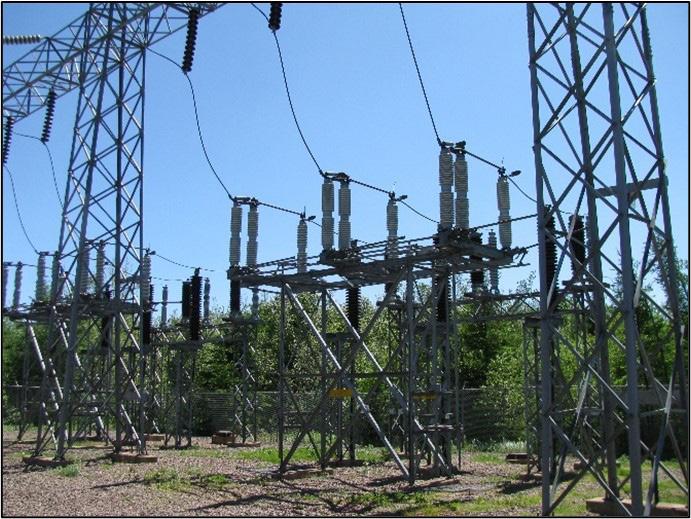




Action 3.1
Continue the construction of structural steel substations for all new and refurbished substations (ongoing)
Maritime Electric will continue to construct new substations and complete substation refurbishments using structural steel members, wherever possible. Structural steel members are more durable than lattice steel structures and less prone to structural deterioration. Structural steel members are also more physically stable than wood structures, which is beneficial in substations where several structures are interconnected to support equipment. The strength and durability of structural steel substations make them more resilient towards future extreme weather events, including high wind and ice storms. Structural steel substations also eliminate the potential wildfire fuel load that wood substations represent. Maritime Electric intends to construct all new substations and refurbish existing ones with structural steel due to its superior resilience towards climate events and increased clearances for the safety of personnel working in substations.
When Maritime Electric completed its Risk Assessment, wildfire risk was deemed as a moderate risk.25 However, since the assessment, there have been record-breaking wildfires across Canada, including those in neighbouring provinces of Nova Scotia and New Brunswick. These recent wildfires and downed trees from weather events demonstrate the need for increased wildfire planning and risk mitigation.
There are two types of wildfire risks for Maritime Electric: (1) the climate risk that a wildfire impacts Maritime Electric’s infrastructure, which was deemed as moderate in the Risk Assessment; and (2) the business risk that Maritime Electric’s infrastructure causes a wildfire, which was not assessed in the Risk Assessment but will be included in future evaluations (see Action 4.1). Maritime Electric must consider both of these risks as temperatures and the probability of heat waves increase due to climate change.
Action 4.1
Complete a detailed evaluation of wildfire risks to identify risk mitigation strategies (planned)
Maritime Electric will complete a detailed evaluation of wildfire risk to evaluate the risk of Maritime Electric’s infrastructure starting a wildfire and identify mitigation strategies to reduce them. The evaluation will include a review of risk mitigation strategies utilized in other jurisdictions. As part of the evaluation, Maritime Electric will also review transmission lines that traverse densely wooded areas and evaluate options for widening the right-of-way in those areas.26 High-risk areas will be prioritized for widening.
25 Wildfires received high consequence scores but the probability of them occurring on PEI was deemed as low.
26 A right-of-way is a land area in which Maritime Electric has a legal right to pass over.

Maritime Electric owns several buildings, including storage facilities for tools and equipment, office buildings and substation control buildings. Substation control buildings, in particular, are critical infrastructure that ensure the efficient operation of a substation. Maritime Electric’s new substation control buildings are designed by a licensed structural engineer according to the National Building Code of Canada. New buildings include concrete foundations, 2x6 walls, vertical roof truss bracing and roof truss hurricane anchors. The new control buildings also include industrial-grade exterior doors, steel roofs and steel siding. These features ensure that new control buildings can withstand extreme weather events. Substation control buildings are also inspected monthly to ensure there are no deficiencies, and buildings are repaired as required.
Action 5.1 Conduct an evaluation of critical buildings to evaluate their effectiveness to withstand hurricane-force wind (planned)
Although Maritime Electric has not experienced significant damage to buildings from weather events in the past, the ability of older buildings to withstand hurricane-force wind is unknown. Maritime Electric will conduct a review of all substation buildings to evaluate their structural integrity and determine whether structural reinforcement or complete building replacement is required. The review will include visual inspections of the roof structures, exterior doors and windows for deficiencies. Based on the results of the building evaluations, Maritime Electric intends to add substation building retrofits to its existing Substation Modernization Program in order to increase resilience towards high wind.27 Retrofit recommendations will be provided by a structural engineer, where applicable.
6 Complete a detailed flood risk analysis for the Charlottetown Generating Station site prior to installing new infrastructure
The Charlottetown Generating Station site, located near the Charlottetown Waterfront, has previously flooded during extreme rain and storm surge events. The site includes a steam plant building that is being demolished, an Energy Control Centre building, a substation, a combustion turbine generator, a water treatment building and a diesel fuel tank farm. In January 2000, flooding occurred in the basement area of the steam plant building, resulting in equipment needing to be elevated to prevent impacts from future flood events. During the January 2000 flooding event, other on-site infrastructure was not affected (the substation equipment is elevated on a steel structure). When Maritime Electric installed the combustion turbine generator on the site in 2005, it was designed and constructed at an appropriate elevation to withstand flooding impacts. A detailed flood risk study is recommended prior to installing new infrastructure to ensure that future sea level rise, storm surge and extreme rainfall will not impact the infrastructure.
27 Maritime Electric’s Substation Modernization Program is a reoccurring capital program that updates existing substations to meet current standards.

Action 6.1
Complete a detailed flood risk assessment for the Charlottetown Generating Station site prior to new infrastructure being installed (planned)
In 2020, Maritime Electric completed an internal storm surge and flooding assessment of the Charlottetown Generating Station site, which included elevation measurements at various locations across the site. Maritime Electric will leverage the 2020 assessment by completing a detailed flood risk assessment for the site in the near future. A study specific to the site will ensure that future infrastructure is designed at an appropriate elevation or that flood mitigation measures are applied. The study will also help address any stormwater drainage deficiencies, if any. Maritime Electric plans to complete a flood risk study for the site prior to installing any additional infrastructure.
Maritime Electric has not experienced significant impacts from coastal flooding in the past; however, given PEI’s coastal landscape and historical coastal erosion rates, future coastal flooding impacts are possible. In 2023, Maritime Electric added Coastal Hazards Information Platform (“CHIP”) flood hazard data, provided by the Government of PEI, to its Geographic Information System (“GIS”) mapping tools, as shown in Figure 11.28 Maritime Electric is using the mapping tools to evaluate infrastructure flood risks for existing and new infrastructure.
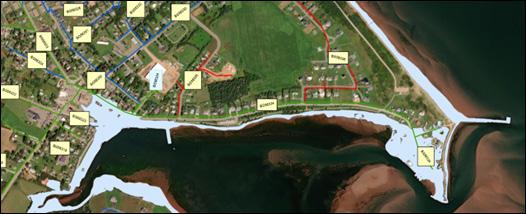
Transmission and distribution lines, including poles, can withstand occasional flooding depending on the severity. Substations and underground infrastructure, however, are more susceptible to flooding damage. Maritime Electric’s infrastructure located in flood hazard areas include the substation located at the Charlottetown Generating Station (see Action 6.1) and several underground vaults located in downtown Charlottetown.

Action 7.1
Use flood mapping tools to evaluate flood risks for existing and new infrastructure (in progress)
Maritime Electric will explore opportunities to evaluate flood risks for its existing infrastructure using GIS tools, including the CHIP flood hazard mapping tools provided by the Government of PEI. Maritime Electric intends to complete an analysis to identify areas where transmission lines, distribution lines and other infrastructure fall in the CHIP 2020 and 2050 flood hazard areas. The number of poles and kilometers of line in flood hazard areas will help Maritime Electric further evaluate its exposure to flood risk and prioritize flood risk mitigation work. Maritime Electric will also continue to use flood mapping tools when planning for and designing new infrastructure, such as new distribution lines, transmission lines and substations.
Action 7.2
Continue to inspect underground vaults biennially (ongoing)
Maritime Electric maintains underground vaults as part of its underground distribution system located in downtown Charlottetown. Vaults are isolated underground enclosures that contain distribution equipment critical for the delivery of electricity to customers in the area. Equipment located in the vaults includes switching points for distribution feeders and transformers. Vaults can be at risk of flooding from storm surge or extreme rainfall events.
Maritime Electric inspects the vaults in Charlottetown biennially to evaluate their condition and the electrical equipment within them. Inspectors evaluate the condition of the concrete and take thermal images of the electrical equipment to identify hotspots. Inspectors also inspect the condition of transformer tanks, primary load-break elbows and secondary connections. If water is present in the vault, inspectors note the presence of water and evaluate whether the drainage system is functioning properly.29
Maritime Electric records vault inspection results using an Underground Facility Inspection Report. If the inspector identifies deficiencies during the inspection, maintenance items are created to address the deficiencies in a timely manner. Typical maintenance items include pumping water out of the vault and installing new submersible termination connections for primary, secondary and ground connections. In the past, the process of pumping out water on an annual basis has successfully prevented damage to electrical equipment located in vaults; however, the increased likelihood of extreme rain events due to climate change poses increased risks to vaults. As part of Maritime Electric’s vault inspection enhancements, Maritime Electric will inspect vaults following extreme rain events and use the results to determine whether the installation of permanent submersible pumps or the relocation of infrastructure above ground is required for select vaults.
In 2023, Maritime Electric added data from the Government of PEI’s CHIP to its GIS mapping tools. Figure 12 shows Maritime Electric’s vaults in Charlottetown with the CHIP 2100 moderate-low flood hazard area. The King Street vault is located within 15 metres of a moderate-low flood hazard area and other vaults are located over 100 metres away from flood hazard areas. The CHIP data demonstrates that the likelihood of
29 Only some of Maritime Electric’s vaults contain drainage systems.

vaults flooding due to sea level rise or storm surge is low compared to the likelihood of vaults flooding due to extreme rainfall events. If a vault is flooded, the electrical equipment in the vault can be partially or fully submerged, which increases the likelihood of equipment failure. To decrease the risk of equipment failure, Maritime Electric will perform vault inspections directly following extreme rainfall events that exceed 106 mm of rain in 24 hours.30 If equipment is submerged, Maritime Electric will pump water out of the vault immediately to minimize the amount of time that the equipment is submerged.
Maritime Electric’s existing Underground Facility Inspection Report includes an area for inspectors to record whether water is present in a vault but does not require inspectors to record the depth of the water level. Maritime Electric will add water level measurements to the report to help track water levels and evaluate trends over time.

30 106 mm of rainfall in 24 hours represents a historical 1-in-25-year rainfall event.

Each year, Maritime Electric’s system reliability is impacted by trees contacting power lines. Tree contacts most commonly occur during high wind or ice storm events, which result in customer outages. Additionally, the Risk Assessment showed that climate change (i.e., hotter and more humid weather, increased precipitation and longer growing season for trees) will improve growing conditions and increase growth rates for vegetation on PEI.
Hurricane Fiona resulted in an estimated 40,000 fallen trees and large branches that impacted the transmission and distribution system. The majority of these large trees were located outside of the public right-of-way and resulted in significant damage to electrical infrastructure, including damaged conductors, distribution poles and transformers. Since Hurricane Fiona, Maritime Electric has been investigating new methods to further improve vegetation management.
A Vegetation Management Plan Report, recently submitted to IRAC, outlined Maritime Electric’s hybrid approach to vegetation management, combining both an increase in risk-based vegetation management and targeted cycle-based vegetation management. Risk-based vegetation management involves identifying high-risk areas for vegetation management. Cycle-based vegetation management involves targeting specific circuits on a cyclical schedule. Increases in vegetation management budgets and the implementation of new programs and technologies will help Maritime Electric perform more targeted risk-based vegetation management, while gradually increasing the level of cycle-based vegetation management.
Action 8.1 Implement a new right-of-way widening program (planned)
In its 2024 Capital Budget Application to IRAC, Maritime Electric requested approval for two new recurring capital programs for transmission and distribution corridor widening. Most of Maritime Electric’s lines are constructed on the edge of provincial rights-of-way, as shown in Figure 13. The objective of the corridor widening programs is to secure wider corridors that will allow the removal of vegetation that is currently outside or adjacent to the provincial rights-of-way. Removal of vegetation adjacent to lines provides multiple benefits, including reduced risk of tree contacts and wildfire from new growth and reductions in future vegetation management requirements. Maritime Electric will continue to collaborate with the Government of PEI to improve the effectiveness of the vegetation management program through legislative authority or some other means to manage vegetation on private property directly adjacent to the public right-ofway to maintain the safety and reliability of the transmission and distribution system.

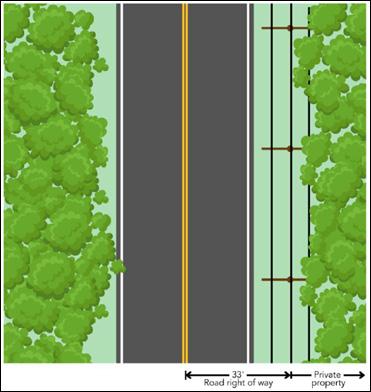
13: Power Lines in Provincial Rights-of-Way
Action 8.2 Increase the vegetation management budget (in progress)
Over the past five years, Maritime Electric has progressively increased its investments in vegetation management and the 2024 Capital Budget Application requested approval for two new recurring capital programs for transmission and distribution corridor widening (see Action 8.1). If approved, the capital programs will increase the total investment in vegetation management to approximately $4.4 million in 2024 and $5.2 million in 2025. By 2025, Maritime Electric projects its annual vegetation management budget to be more than double of its 2021 budget. Further budget increases will be required because of increasing tree growth rates due to increasing temperatures, longer growing seasons and increasing precipitation.
Action 8.3 Evaluate the use of satellite technology for vegetation management planning (in progress)
Maritime Electric is currently exploring the use of satellite-based software technologies to enhance the vegetation management planning process. Satellite-based technologies use high-resolution satellite imagery and predictive models to analyze current vegetation condition, growth rates and risk. Maritime Electric can use the software technology to prioritize its vegetation management efforts and monitor progress over time. The software also typically offers planning, cost estimating, execution and audit modules.

Maritime Electric is currently conducting a pilot project with a satellite-based vegetation management technology, which will analyze approximately 275 kms of distribution line across three circuits and 27 kms of transmission line. The three distribution circuits were selected based on their reliability performance, differing types of vegetation condition, and combination of suburban and rural environments. Figure 14 shows an example of the initial assessment for distribution lines prior to field verification.
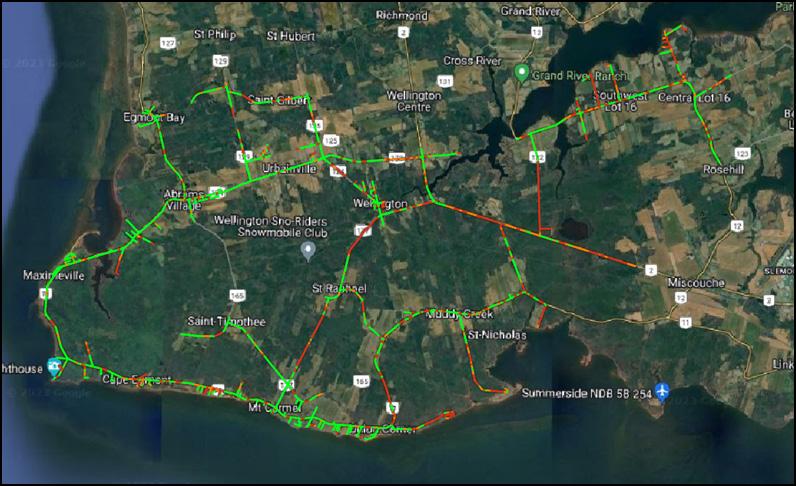

Action 8.4 Develop a vegetation education and planting information campaign (in progress)
Maritime Electric is actively working with municipalities and private landowners to promote planting trees away from power lines as part of a vegetation education and planting information campaign. Examples of marketing materials distributed to municipalities and customers is provided in Appendix B: Vegetation Education and Planting Promotional Materials. In 2023, Maritime Electric also launched a Right Tree Right Place campaign to promote and educate municipalities and landowners about planting low-growth tree species near power lines and safe distances to plant trees away from power lines and updated its Tree Planting Guide, which is provided in Appendix C: Tree Planting Guide.

Strategy 9
Continue to monitor coastal erosion near subsea cable termination sites
Sea level rise and storm surge has the potential to impact subsea cable land termination areas if significant costal erosion occurs. Although not identified as an immediate risk in the Risk Assessment, coastal erosion was identified as a significant risk for PEI by the Government of PEI.31 In 2017, Maritime Electric constructed riser stations in Borden-Carleton and Cape Tormentine to terminate two new 138 kV subsea cables between PEI and New Brunswick, which included the installation of stonewalls for shoreline protection to prevent erosion near the subsea cables.32 Annually, Maritime Electric inspects the stonewalls to ensure that they remain in good condition. Maritime Electric also maintains the original two subsea cables that were installed in 1977; however, the riser stations and associated subsea cable equipment for these cables are located further from the shore. All stations and associated equipment are inspected routinely, and the subsea cables are inspected biennially by divers. The four subsea cables and their termination sites are critical to maintain Maritime Electric’s supply of electricity from NB Power. Maritime Electric will continue to monitor coastal erosion near the four cable termination sites on PEI and in New Brunswick.
Action 9.1
Develop a standardized inspection report to document the condition of the shoreline near subsea cable terminations on PEI and in New Brunswick (complete)
Coastal erosion caused by sea level rise and storm surges could impact the four subsea cable termination areas. To monitor coastal erosion, inspections should occur after each storm surge event. In 2023, Maritime Electric developed a new form to document and inspect results for the four subsea cable termination locations on PEI and in New Brunswick, which is provided in Appendix D: Subsea Cable Shoreline Inspection Form. The inspection form includes the following:
• Inspection of the shoreline for sink holes or heaving;
• Inspection of armor stone shoreline protection wall (if applicable) for deterioration;
• Inspection of road crossings for sink holes or heaving;
• Inspection of right of way for sink holes, heaving or public interference; and
• Photograph documentation of site conditions.
The inspections will be completed following major storm surge events.

Strategy 10 Continue to implement redundancy within the electrical grid
Adding redundancy to the electrical grid provides flexibility to supply electricity to customers from alternate routes in the event of an outage. Examples of electrical grid redundancy include adding subsea cables and transmission lines, creating transmission loops, adding capabilities to feed circuits from alternate substations and adding redundancy to equipment within substations.
In 2017, with the Government of PEI, Maritime Electric acted as the construction agent and installed two new subsea cables that connect PEI to New Brunswick, which increased the total number of subsea cables to four. The ability to supply electricity via four subsea cables provides PEI with redundancy in the event that one of the cables were to fail. In 2017, Maritime Electric also completed a new 138 kV transmission line Y-104 and expanded a substation in Church Road to create a transmission loop in Eastern PEI. In the event of a fault on one of the transmission lines, the transmission loop allows customers to be serviced from the alternate transmission line.
Maritime Electric is continuously expanding existing and constructing new substations to service increasing customer loads and, in some cases, this provides additional redundancy to the distribution system. For example, in 2020, Maritime Electric constructed a new substation in Clyde River to service customers in Cornwall and surrounding areas, who were previously serviced from the West Royalty substation. At the time, electrical switching devices (e.g., reclosers) were installed to allow customers in the area to be serviced from either the new Clyde River substation or the existing West Royalty substation, providing backup options in the event of an outage. Adding new substations also decreases the length of substation feeder circuits, which further improves reliability by reducing the number of customers affected by an outage on a particular circuit.
When Maritime Electric expands existing substations or constructs new ones, it includes redundancy in the substation design. For example, Maritime Electric includes spare transformer bays in new substations to accommodate a mobile power transformer (i.e., a power transformer on a movable trailer). The mobile power transformer can be quickly connected to the substation if a failure occurs to any of the permanent power transformers. The practice of including spare transformer bays is a cost-effective way to add redundancy to critical substation power transformers.
Action 10.1 Complete a transmission loop in Western PEI to increase redundancy (in progress)
In 2023, Maritime Electric received regulatory approval to construct a switching station in Western PEI, which will create a transmission loop in the region. The transmission loop will improve reliability in Western PEI as it will provide an alternate route for Maritime Electric to serve customers in the event of an outage to one of the transmission lines. The project is expected to be completed by 2025.

Action 10.2 Add an additional autotransformer to the Lorne Valley Switching Station and convert T-4 to 138 kV (planned)
Eastern PEI is currently supplied via two transmission lines: (1) a 69 kV transmission line (T-2) originating from the substation at the Charlottetown Generating Station; and (2) a 138 kV transmission line (Y-104 and Y-102) originating from the West Royalty substation. These lines create a 155 km transmission loop, as shown in Figure 15, which supplies power to approximately 30 per cent of Maritime Electric’s customers. Transmission line T-4 is not currently connected to the Y-104 transmission feed, as the lines are energized at different voltages. Adding an additional autotransformer to the Lorne Valley switching station and converting T-4 to 138 kV will offload existing autotransformers in the West Royalty substation and provide further redundancy to the 138 kV transmission system for Eastern PEI. The installation of an additional autotransformer in Lorne Valley and the replacement of T-4 is currently planned to start in 2025, subject to regulatory approval.
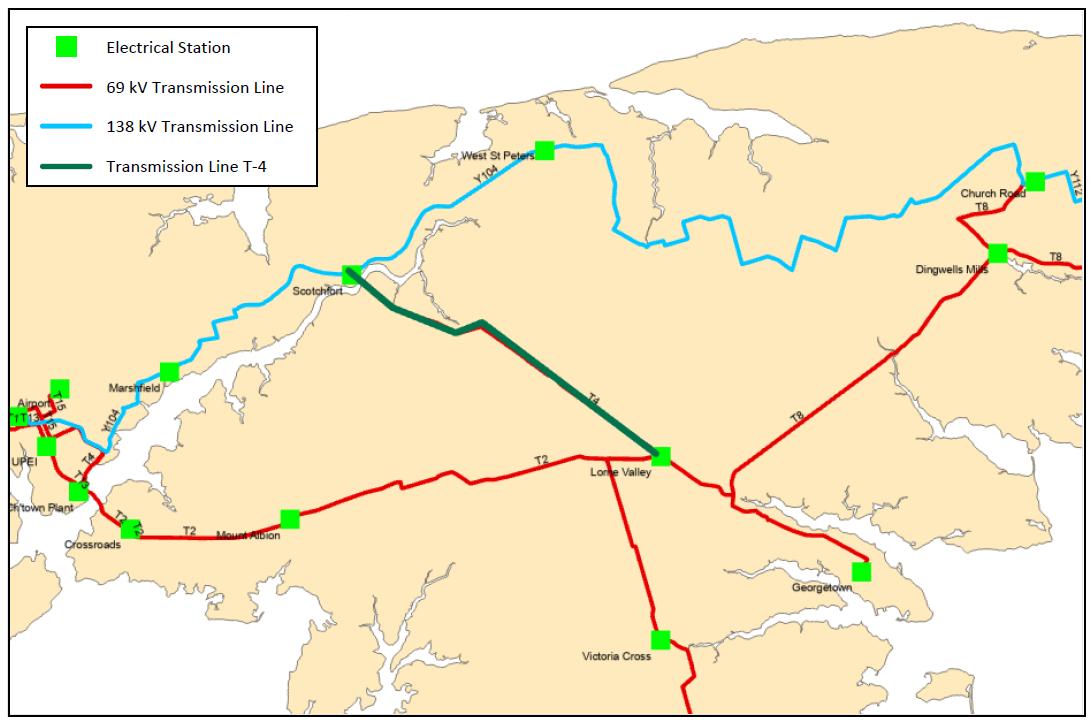
Action 10.3 Extend three-phase distribution lines to provide redundancy (ongoing)
Redundancy on the distribution system can lead to increased reliability during distribution system outages. Maritime Electric is gradually extending strategic three-phase circuits to connect them to other threephase circuits from neighbouring substations, which serves new customers along the route and allows backup from neighbouring substations. For example, in 2023, Maritime Electric completed a 2.5 km three-

phase line conversion on the Robertson Road in Mount Albion, which bridged a 1.1 km gap between two three-phase lines. The new line allows Maritime Electric to transfer load from the Crossroads substation to the Mount Albion substation, which will improve reliability by providing a backup option for approximately 1,800 customers on the Bunbury feeder (from the Crossroads substation). Maritime Electric will prioritize the extension of similar three-phase lines to provide redundancy from different substations and strengthen reliability.
Action 10.4
Implement more widespread use of Distribution Automation Systems (planned)
A Distribution Automation System (“DAS”), as defined by the Institute of Electrical and Electronic Engineers, is a system that enables an electric utility to monitor, coordinate, and operate distribution components in real-time from remote locations.33 It is an integrated solution of field apparatus, devices, communications and software applications designed to optimize power grid efficiency, reliability, and resilience.
The benefits of DAS implementation include:
• Improved reliability by reducing outage duration using auto restoration schemes;
• Improved voltage control by means of automatic Volt-Amps Reactive (VAR) control;
• Accurate and useful planning and operational data information;
• Improved fault detection and diagnostic analysis;
• Improved management of system and component loading; and
• Improved utilization of system capacity.
A reliable and cybersecure communication system is critical to a DAS. Maritime Electric is actively working to implement a robust communication system to support DAS by upgrading its communication infrastructure between its Energy Control Centre and substations through the installation of fibre optic lines. The preferred routes for the fibre optic lines are along main distribution feeder lines to facilitate the integration of Supervisory Control and Data Acquisition (SCADA) controlled field devices, including reclosers, voltage regulator controllers and capacitor controllers.34
Maritime Electric will develop a DAS plan and intends to complete a DAS pilot project for a selected area. Maritime Electric is investigating available funding opportunities for the pilot project.
The most significant factor to the timing of planned maintenance and load benchmarks is ambient temperature. For example, scheduled system maintenance is typically avoided during the winter months when electricity load is highest due to home heating requirements. Similarly, peak load analyses and forecasts are based on the coldest day of the year. As the climate on PEI warms and customers utilize
33 Gruenemeyer, Donald. 1991. “Distribution Automation: How should it be evaluated?” Rural Electric Power Conference. Dearborn, MI, USA: IEEE.
34 A Supervisory Control and Data Acquisition system is a system of inputs and controls that allows users to monitor and process real-time data.

more air conditioning, summer peak load will increase. The annual peak load is expected to continue to occur during the winter months, but an increase in summer load could impact summer maintenance schedules. Maritime Electric continuously updates its planned maintenance scheduling based on previous and expected peak loads.
Action 11.1 Continue to use updated extreme climate benchmarks for maintenance and demand planning (ongoing)
Maritime Electric’s Corporate Planning department has already incorporated climate change projections in its planning processes. The department uses extreme maximum and minimum temperatures to estimate future peak loads. Extreme maximum temperatures, in particular, are used to determine the electrical capacity of power transformers located in substations, since the efficiency and capacity of power transformers decrease as the ambient temperature increases. The department also uses the number of heating degree days and cooling degree days to estimate future loads.
Maritime Electric purchases a significant amount of its energy from NB Power through four subsea cables. In 2022, approximately 73 per cent of electricity delivered to customers came from NB Power imports, which is purchased from NB Power through energy purchase agreements.
Action 12.1 Increase the transmission capacity for electricity imports from NB Power (ongoing)
In October 2023, New Brunswick and Nova Scotia announced their intentions to abandon the Atlantic Loop project, aimed at expanding the transmission capacity in Atlantic Canada, due to the project’s high cost. Maritime Electric is discussing options with NB Power to increase the transmission capacity for electricity imports to PEI, despite the Atlantic loop project being abandoned. Other options exist to increase the transmission capacity that would have similar benefits as the Atlantic Loop project, which the Atlantic Provinces are evaluating.
Action 12.2
Review transmission automation options for the New Brunswick corridor transmission lines (planned)
Currently, if an outage occurs on any of the NB Power transmission lines that deliver electricity to PEI, required protection and control schemes can extend outage durations. The protection and control schemes are required to protect Maritime Electric and NB Power’s electrical infrastructure from potential damage. Maritime Electric plans to evaluate automation options for the protection and controls schemes for the New Brunswick corridor transmission lines to determine whether the duration of outages can be reduced safely.

Maritime Electric currently owns and operates three combustion turbines used for backup power generation, with a combined capacity of 90 MW. In February 2023, PEI experienced a record peak load of 393.6 MW during a polar vortex weather event. The peak load was 22 per cent higher than the previous record peak (January 2022). As Maritime Electric’s peak load continues to increase and the Maritime provinces experience capacity shortages due to electrification and the federally mandated closure of all coal-fired generation by 2030, more generating capacity is required to avoid rotating blackouts for customers. Additional generating capacity can also provide emergency backup power in case of outages to the New Brunswick transmission system or subsea cables that connect PEI to New Brunswick, which recently occurred in February 2024.
Action 13.1 Implement recommendations from the Capacity Resource Study (planned)
In 2021, Maritime Electric completed a Capacity Resource Study (“Capacity Study”) and Extreme Weather Event Capacity Impact Addendum Report (“Addendum Report”) to evaluate PEI’s capacity requirements, which concluded that Maritime Electric needs more dispatchable generation to support load growth and for security of supply.35,36 The Capacity Study and Addendum Report recommended installing dispatchable generation. Maritime Electric is currently in the process of preparing an application to IRAC to install additional on-Island dispatchable generation, which is expected to be filed in 2024.
Strategy 14 Continue to maintain the backup radio system to allow continued communication in the case of disruptions to the fibre system
Maritime Electric owns and maintains radio and fibre optic communication networks between substations and the Energy Control Centre. Energy Control Centre operators use the communication networks to monitor energy flows through the transmission system and to operate substation devices. In recent years, Maritime Electric modernized its communication network by expanding its network of fibre optic lines; however, Maritime Electric continues to maintain its radio network as a backup. The backup radio network was valuable during Hurricane Fiona in 2022, as the storm impacted Maritime Electric’s fibre optic network.
Action 14.1 Continue to maintain Maritime Electric’s backup radio network for communication until redundancy is established in the fibre optic network (ongoing)
Maritime Electric will continue to maintain its backup radio network for communication until redundancy is established for its fibre optic network. If Maritime Electric’s application to install Advanced Metering Infrastructure is successful, Maritime Electric will evaluate the potential of using the Advanced Metering Infrastructure communication network as an alternative to its existing radio network as a backup.
35 Sargent & Lundy. 2022. “Capacity Resource Study - Evaluation of Various Technology Options for Maritime Electric Company.” Chicago, IL.
36 Sargent & Lundy. 2023. “Extreme Weather Event Capacity Impact - Addendum to December 2022 Maritime Electric Capacity Resource Study.” Chicago, IL.

In the past, Maritime Electric’s practice was to allow employees to use their judgment while working during an extreme weather event. Additionally, if a lightning storm is approaching, Maritime Electric’s Energy Control Centre operators alert field crews, who halt work and take shelter immediately. Due to climate change and the increasing frequency and intensity of extreme weather events, including higher temperatures during summer months, a formal procedure should be created to clarify actions required to protect the health and safety of employees during extreme weather events.
Action 15.1 Develop an employee safety procedure for working in extreme weather (complete)
In 2023, Maritime Electric created a new procedure that outlines actions required during extreme weather events. The procedure outlines potential illnesses and symptoms associated with exposure to extreme heat or extreme cold. The procedure also outlines guidelines for working in extreme weather events such as high wind and heavy precipitation. The procedure is provided in Appendix E: Guidelines for Working in Extreme Weather Procedure.
The Risk Assessment identified several climate-related risks toward human resources working outdoors. Below is a list of high risks identified:
• Extreme cold temperatures pose a risk of hypothermia and frostbite;
• Extreme heat poses a risk of heat stroke and dehydration;
• Ice storms and freezing rain create a risk of slips and vehicle collisions;
• Lightning poses a risk towards personnel, especially those working on the electrical system; and
• Hurricanes and extratropical storms pose a risk towards personnel who are working on the electrical system or driving.
Maintaining a strong safety culture and raising awareness of climate-related health and safety risks will become increasingly more important as a result of climate change.
Action 16.1 Provide Maritime Electric employees with appropriate weather-related personal protection equipment (ongoing)
Maritime Electric provides personnel with appropriate weather-related personal protective equipment (“PPE”), including insulated jackets, insulated pants, rain gear, work boots, ice cleats, hard hats and shaded safety glasses. Maritime Electric is also committed to supplying personnel with sunscreen and water at all times of year to protect employees from the sun and to ensure they remain hydrated. Procedures are in place to ensure employees receive the appropriate PPE to protect them from weather conditions. Maritime

Electric maintains a Joint Occupational Health and Safety Committee, comprised of employees from various departments to address safety gaps, including weather-related PPE.
Action 16.2 Continue to discuss weather-related health and safety risks (ongoing)
Maritime Electric is grounded in decades of high safety standards. Safety meetings are held monthly with various departments to review health and safety in the workplace, including weather-related safety. Weather-related safety discussions include, but are not limited to, slip hazards from ice, road conditions while driving and the importance of hydration while working outdoors in high temperatures. Maritime Electric will continue to discuss weather-related safety and will review the new Guidelines for Working in Extreme Weather Procedure (see Action 15.1) during safety meetings.
Strategy 17 Add heat pumps in substation buildings that are frequently occupied by Maritime Electric personnel
All of Maritime Electric’s newly constructed substation control buildings include heat pumps for heating and cooling. Maritime Electric is working towards installing heat pumps in all of its existing substation buildings, which predominately contain electric baseboard heating systems. In 2022, Maritime Electric installed heat pumps in its control buildings at the Borden Generating Station, which can be occupied for extended periods of time during the operation of combustion turbines. The control buildings were previously either cold or hot during the winter or summer periods, respectively.
Action 17.1 Ensure that heat pumps are installed in substation control buildings (planned)
Maritime Electric will continue to install heat pumps in all new substation control buildings and will seek approval to add the installation of heat pumps in existing substation control buildings through its substation modernization program.

Maritime Electric’s Operations and Engineering departments will be responsible for implementing the strategies outlined in the Adaptation Strategy. The Sustainability Department will be responsible for monitoring and reporting on the implementation of the strategies and action items.
The Sustainability Department will continue to monitor emerging climate information and industry best practices for climate change adaptation. Climate data and adaptation strategies will be updated as new information becomes available. Maritime Electric intends to update its Risk Assessment at a minimum every five years to include current climate change projections and review its climate change risks based on adaptation efforts. Maritime Electric also plans to monitor progress towards completing the climate change adaptation strategies and action items.
Updates of Maritime Electric’s sustainability and climate change adaptation work is provided to Maritime Electric’s Human Resources and Corporate Governance Committee of the Board of Directors. Fortis Inc. also provides oversight on climate change adaptation and the Fortis Operating Group, comprised of all Fortis companies, shares climate change adaptation and resilience resources. Local climate expertise on PEI, strong governance from Maritime Electric’s Board and oversight from Fortis Inc. allows for Maritime Electric to be well positioned for implementing effective climate change adaptation strategies.

Gruenemeyer, Donald. 1991. “Distribution Automation: How should it be evaluated?” Rural Electric Power Conference. Dearborn, MI, USA: IEEE.
Havard, D. G. 2007. Conductor Galloping: A Tutorial Presented at the IEEE ESMOL and TP&C Meeting. Las Vegas, January.
ICF International Inc. 2021. Prince Edward Island (PEI) Climate Change Risk Assessment. Government of Prince Edward Island.
Kuiper, Jason. 2020. How does that work? Air-flow spoilers. December 28. https://oppdthewire.com/air- flow-spoilers-how-works/.
Nimpa, G. D., J. M. Njankouo, P. S. Ngohe-Ekam, and T. Tamo Tatiestse. 2017. “Life Cycle Assessment of Power Utility Poles – A Review.” International Journal of Engineering Science Invention 6 (2): 16-32.
Sargent & Lundy. 2022. “Capacity Resource Study - Evaluation of Various Technology Options for Maritime Electric Company.” Chicago, IL.
Sargent & Lundy. 2023. “Extreme Weather Event Capacity Impact - Addendum to December 2022 Maritime Electric Capacity Resource Study.” Chicago, IL.
Stantec Consulting Ltd. 2022. PIEVC Assessment for Maritime Electric Company Ltd. Charlottetown: Maritime Electric Company, Ltd.
Task Force B2.11.06. n.d. “State of the Art of Conductor Galloping: A Complementary Document to “Transmission Line Reference Book –Wind-Induced Conductor Motion Chapter 4: Conductor galloping,” Based on EPRI Research project 792.”


StantecConsultingLtd.
165MapleHillsAvenue,CharlottetownPEC1C1N9
Table1SummaryofClimateDataforWind,Temperature,andPrecipitationExtremeEvents
ClimateParameters
(1833) (3453) (3858) (4263)
Extremerainfall1-hourduration(mm)18.7F25.4F33.344.836.949.740.554.5
(24.426.1) (43.148.6) (47.753.9) (52.459.2)
Extremerainfall24-hourduration(mm)60.5F82.1F106142117158128173Moderate (78.984.3) (137155) (151171) (166187)
Notes:
ATheaverageoftheannualextremevaluesforeachclimateparameter
BProjectedvaluesincludethemedianvalue,alongwiththe(10th90th)percentile.
CBaselinevaluesoficeaccretionwereestimatedusingtheChainémodelfollowingCSA22.3No.60826:19
DValuesinparenthesesarethe25thand75thpercentiles.
EHeatwavesaredefinedas2consecutivedayswithTmax>=28°CandTmin>=18°C.Forexample,ifagivenyearhadonly1daymeetingthatcriteria,thenumberofheatwaveswouldbe0,andsothenumberof daysperyearwithheatwaveconditionswouldalsobe0.Anotheryearwhereoneheatwaveoccurredthatlasted3dayswouldhaveatotalof3daysinthatyearwithheatwaveconditions.
FExtremerainfallaverageisrepresentedasthe2-yearreturnperiodeventfromtheavailableIntensity-Duration-FrequencydataforCharlottetown
Notes
Table2SummaryofClimateDataforSeaLevelRiseandStormSurgenearCharlottetown
ClimateParameter TimePeriod
ProjectionConfidenceLevel BaselineEndofCentury
SeaLevelRise(m)-0.65(0.340.96)AModerate
StormSurge(m) 1-year1.32.1 Moderate 10-year1.82.6 100-year2.23.1
ASeaLevelRiseshownasthemedianalongwiththe5thand95thpercentilevalues






If you are planting new trees, do not plant near or under power lines. Before choosing a place to plant, always check how tall the tree will be when it grows to maturity. A 30 ft. tree at maturity should be planted at least 45 ft. away from power lines to help prevent future safety hazards or risk of power outages. Please do not plant trees near power lines.
To learn more, and to read our tree planting guide, scan the QR code using the camera on your smart device or visit







Islanders, we need your help!
Trees planted near and under power lines interfere with the reliability of your power and may cause power outages.

Scan with your mobile camera to read our tree planting guide!

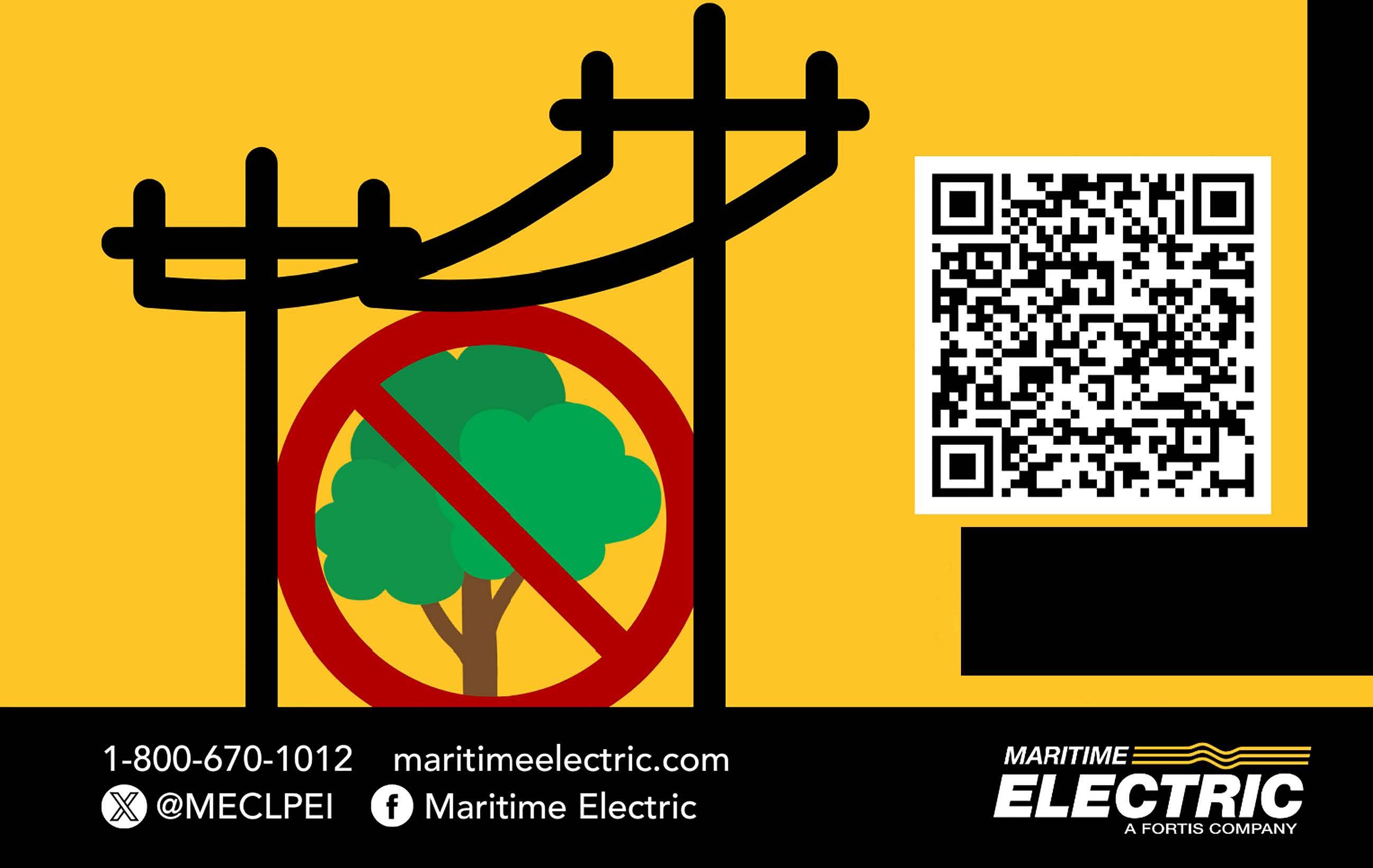


We are committed to providing safe, reliable and affordable electricity for our customers. We also know the importance of planting trees for our environment and communities and plant many trees through corporate programs each year. However, planting trees near or under power lines will result in power outages and create a future public safety hazard. Trees and wind are the number one cause of power outages in Prince Edward Island. Trees planted near and under power lines interfere with the electrical equipment and the reliability of the power being delivered to your home, neighbours and wider community. This is especially true during adverse weather events including high winds and ice storms.

We regularly trim trees away from power lines to ensure the reliability of our electrical system and reduce the risk of public safety hazards, but we need your help. We encourage you to read through this guide, which will assist you in making informed decisions about planting the right tree in the right place. Not only will planting your tree in the right place ensure the best chances of your tree establishing and growing to maturity, but it will also ensure the reliability of the electrical system in your community.
If you are planting a new tree, consider how large it will grow and what it will look like in 10 or even 20 years. Before choosing a place to plant your tree, contact your local tree nursery to determine the mature height of the tree. A 30 ft. tree at maturity should be planted at least 45 ft. away from power lines to help ensure it will not interfere with the power lines in the future. The taller the tree, the further away the tree needs to be planted from the power lines to ensure the reliability of the power system. Only low growing species should be planted in proximity to power lines.
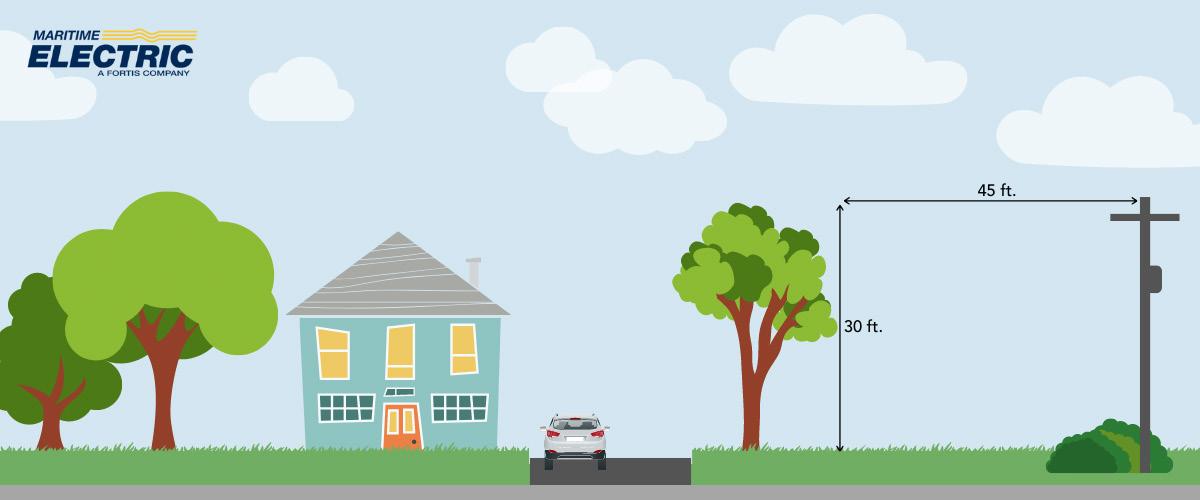

Planting native species is highly recommended as they have adapted for thousands of years to survive and thrive in the conditions on Prince Edward Island. Native species also work to protect the soil and waterways and provide a multitude of other benefits to the PEI ecosystem. Visit MacPhail Woods Ecological Forestry Project’s website for a list of native tree species.





White Spruce
• Mature height: 78 to 98 ft
• Grows best in full sun
• Ideal for hedgerows, in old fields and along the coastline
• Plant very far away from power lines
Sugar Maple
• Mature height: Up to 115 ft
• Grows best in rich, well-drained soil and in dry areas with partial shade
• Does not tolerate windy areas
• Plant very far away from power lines
Red Maple
• Mature height: Up to 82 ft
• Grows best in rich and moist soil, often found near streams and swamps
• Tolerates some shade
• Plant very far away from power lines
Red Oak
• Mature height: Up to 65 to 98 ft
• Grows best in well-drained soil
• Does not tolerate windy areas or very wet soil
• Plant very far away from power lines

1. Identify the trunk flare, which is where the trunk expands at the base of the tree. This point should be partially visible after the tree has been planted.

2. Dig a shallow, broad planting hole that is twice as wide and just as deep as the pot. If the tree is planted too deep new roots will have difficulty developing because of a lack of oxygen.
3. Remove broken or damaged branches. Remove the plastic container and spread the roots out. Inspect the root balls for circling roots. If there are a lot of them circling after being confined in the pot straighten them out or cut them with a knife.
4. If the surrounding soil is dry add water to the hole. Add compost and mix it with the loose soil in the hole.
5. Straighten the tree in the hole. Before backfilling, have someone view the tree from several directions to confirm it is straight.
6. Fill the hole gently but firmly. Pack soil around the base and sides of the root ball to stabilize it.
7. Create a barrier with soil around the tree to hold water.

1. Apply a 2 to 4 inch (5 to 10 cm) layer of mulch (less if poorly drained). Coarse mulches can be applied slightly deeper without harm. Mulch should not come in contact with the tree trunk.
2. Place mulch out to the edge of a tree’s crown or beyond. Trees like their entire root systems to be mulched.
Water your newly planted tree twice per week for the first two months, or three times per week in the summer months.

Keep the area around your newly planted tree weed free. Hand pull weeds to avoid damaging the trunk with a lawnmower or weed trimmer.

Fertilize your new trees annually. Fertilizers with a high nitrogen content are recommended for trees under three years old. Follow the instructions on the package to ensure proper amounts and application.
Properly selected and planted trees around a home can also improve energy efficiency. When trees are planted in the right places they can provide you with energy savings by shielding cold winds during the winter months. Here are a few tips:
• Plant a windbreak of evergreens to the north and west of your house (away from power lines) to provide shelter from the cold winter winds and to help save energy in winter.
• Plant deciduous trees on west and southwest sides (away from power lines) since these trees lose their leaves in the winter. This will allow sunlight to help with heating and therefore help reduce your energy costs.
Good Placement
Deciduous trees are planted to the south and west of the house. These trees will let the warm sun shine into the house in the winter. The windbreak of evergreens to the north side of the property will shelter the house in winter.

Bad Placement
Large trees placed under the power lines have to be trimmed. The large evergreen planted on the south side of the house will prevent the winter sun from warming the house.
Placement
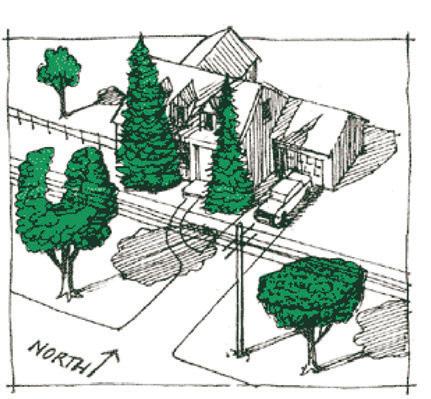
Placement

We understand the importance of planting trees for our environment and communities. However, our ability to provide safe and reliable electricity to over 87,000 customers is affected by the growth of trees. We trim and remove trees to maintain the proper clearance from power lines to ensure the reliability of our system, as well as the safety of Islanders.
Our tree trimming program is aimed at keeping over 6,600 km of transmission and distribution lines clear of trees and undergrowth. Through our focus on effective vegetation management, which includes periodic inspections of power lines, we identify trees that are growing too close to power lines and thus, cause concern for public safety and reliability.
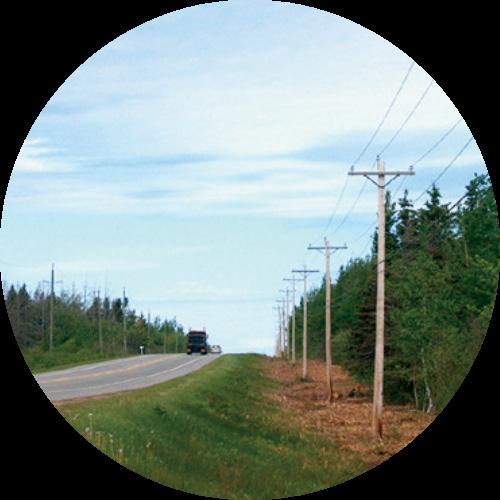

Vegetation and trees have been cleared from power lines to ensure correct distance and safety requirements are in place.
Although it is not possible to predict or foresee all tree-related problems, our tree trimming program is designed to trim trees before safety or reliability problems occur.
We employ contractors whose skilled, professional crews trim trees to provide enough clearance between limbs with minimum inconvenience to you, our customers.
We encourage our contractors to use a natural trimming method, which is proven to be the best method for the long-term health of the tree. They do their best to redirect growth away from the power lines, creating sufficient clearance so that the tree will remain safe until we return for the next routine maintenance.
Never attempt to prune or trim trees near power lines yourself. Contact with a power line can result in serious injury or even death.

At Maritime Electric, we believe safety must be integrated in all we do.
When a tree or a large branch falls onto a power line, as sometimes happens during storms, it can bring down the power line. If anyone touches a downed power line that is still energized, the result can be serious injury, even death.

Children do not always know, or remember, what can be dangerous, so it is up to the rest of us to watch out for their safety. Never build a tree house in the trees near power lines and be careful not to allow kids to climb trees growing near power lines. Teach them to tell an adult if they discover downed power lines in the area. Never attempt to touch an object tangled in a power line. Call Maritime Electric at 1-800-670-1012, for assistance.
Introduced in 2019, Trees for Life is a Maritime Electric employee tree planting event that focuses on community engagement and sustainability. Each year, Maritime Electric purchases trees from Island nurseries and plants them in September at Island schools or parks. Since the program began, we’ve planted hundreds of trees across the Island.
To read more about Trees for Life, and our sustainability goals, visit www.maritimeelectric.com/ sustainability.
We take our job of providing electricity to your home and community very seriously and we appreciate cooperation in supporting our vegetation management program. By working together, we can ensure the safety of you, your families and our employees.
For further information on tree safety or to report a downed limb or limbs in contact with power lines, visit us online at maritimeelectric.com or call us at 1-800-670-1012
If you knew that cutting a tree around an energized power line could cause you or others serious injury or even death, wouldn’t you take a moment to look up? NEVER cut or trim trees near power lines and NEVER attempt to remove a tree that has fallen into a power line.
Contractors, be sure your employees know the dangers of working near power lines. It is your responsibility to ensure they follow the Occupational Health and Safety regulations to protect themselves and others. Put safety first, look up before you cut.
Safety is our priority. Make it yours too!

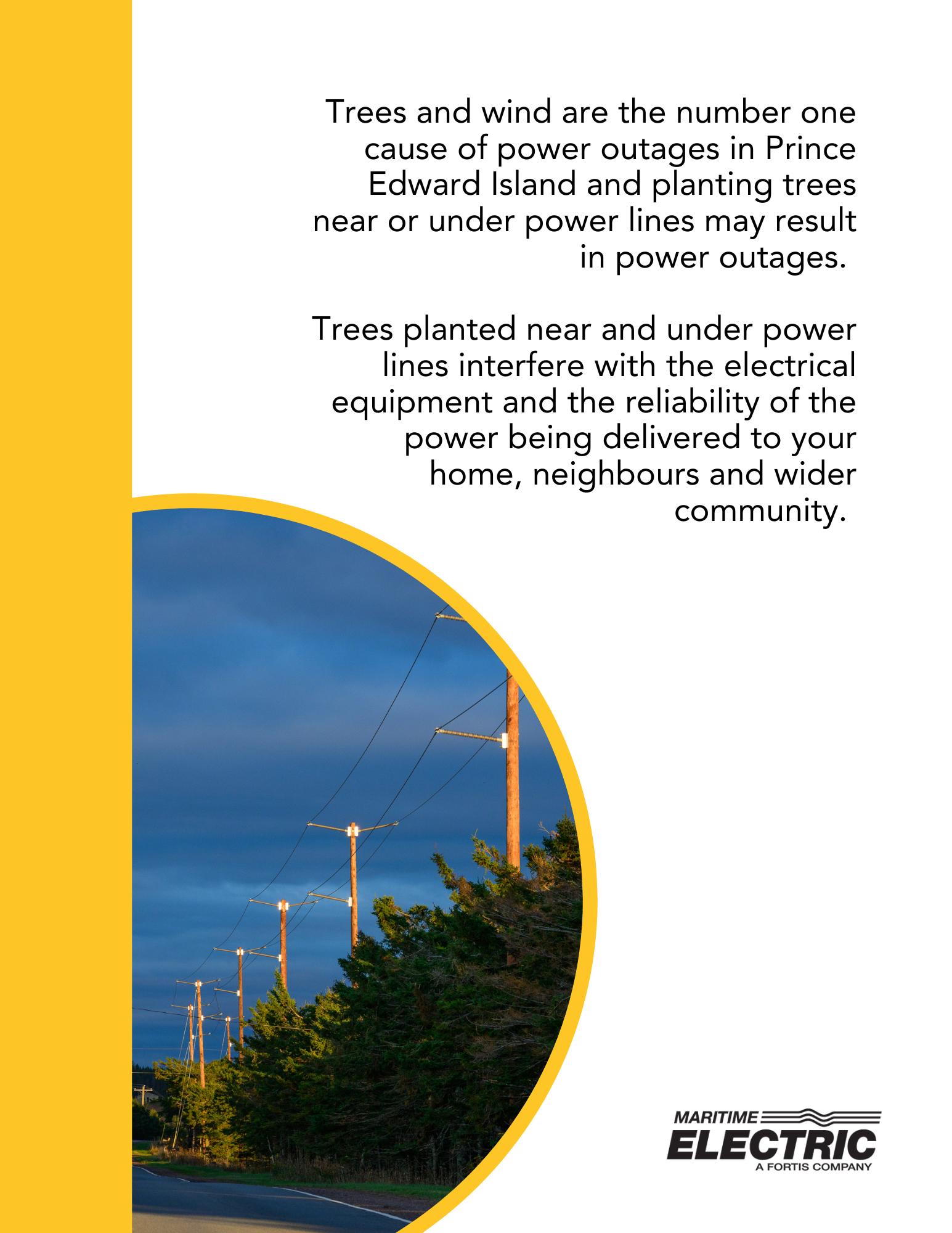

Date:
Richmond Cove
Shoreline beach
Armour stone wall
Right-of-way land area
Inspected By:
Check for sink holes, heaving or signs of oil spills
Check for deterioration or loose rocks
Check for sink holes, heaving or public interference
Photos Take photos of shoreline and right-of way land area
Other:
Murray Corner
Shoreline beach
Armour stone wall
Road crossing
Right-of-way land area
Check for sink holes, heaving or signs of oil spills
Check for deterioration or loose rocks
Check for dips, sink holes or heaving
Check for sink holes, heaving or public interference
Photos Take photos of shoreline and right-of way land area
Other:
Borden-Carleton
Shoreline beach
Armour stone wall
Right-of-way land area
Check for sink holes or heaving
Check for deterioration or loose rocks
Check for sink holes, heaving or public interference
Photos Take photos of shoreline and right-of way land area
Other:
Shoreline beach
Armour stone wall
Road crossing
Right-of-way land area
Check for sink holes or heaving
Check for deterioration or loose rocks
Check for dips, sink holes or heaving
Check for sink holes, heaving or public interference
Photos Take photos of shoreline and right-of way land area
Other:

Comments
Send inspection form and photos to: Manager, Corporate & Capital Planning
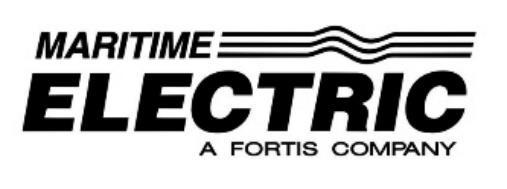
Document 850233
Version # 01
Effective Date May 6, 2024
Owner Manager, Customer Service & Operations
Approver/Title Enrique Riveroll
1.1 The purpose of this procedure is to outline the extreme weather events that Prince Edward Island currently faces or could potentially face as climate changes. For each weather event, there is a description, potential illnesses and symptoms, and recommended safety guidelines. The information outlined in this procedure is considered to be used as a guideline, it should never supersede good judgment if a situation feels unsafe.
2.1 This procedure applies to all employees and applicable contractors whose role requires them to work outside.
3.1 Extreme Cold is temperature with wind chill at or below -35°C in Atlantic Canada or between30°C and -55°C in other regions of Canada.
3.2 Extreme Heat is temperatures at or above 28°C, with nighttime temperatures of 18°C or above on Prince Edward Island or between 28°C and 35°C in other regions of Canada with nighttime temperatures between 13°C to 21°C.
3.3 High Winds are when the wind is sustained at 70 km/h or higher, and/or when there are gusts of 90 km/h or higher
3.4 Heavy Rain is when 25mm or more of rain is expected to fall within one hour within Atlantic Canada and northern provinces and territories or when 50 mm or more of rain is expected to fall within one hour in other regions of Canada.
3.5 Heavy Snowfall is when 15 cm or more of snow is expected to fall within 12 hours or less in Atlantic Canada, Quebec, Ontario, and regions of British Columbia or between 10 cm or 20 cm within other areas of Canada.
Extreme Cold
4.1 Environment and Climate Change Canada issues extreme cold warnings when the wind chill is expected to reach -35°C within Atlantic Canada or between -30°C and -55°C in other regions of Canada There are no legislated maximum/minimum limits for working in the cold, however the following guidelines should be used when the wind chill temperature is at or below -12°C:
▪ Adjust pace of work to avoid heavy sweating resulting in wet or damp clothing;
▪ Dress in layers so that you can adjust to changing weather; try not to overdress;
▪ Allow additional time for new employees to adjust to the conditions;
Page 1 of 9
▪ Account for additional weight and bulk of clothing when estimating performance and lifting heavy weights;
▪ Minimize sitting or standing for long periods of time;
▪ Consume warm fluid and light snacks to provide energy, warmth and to avoid fluid loss;
▪ Work with the wind at your back, if possible; and
▪ Rotate shifts in a heated vehicle
4.2 The symptoms of different cold related illnesses are listed below.
Hypothermia:
▪ Confusion
▪ Dizziness
▪ Memory Loss
▪ Exhaustion
▪ Slurred speech or mumbling
▪ Drowsiness
▪ Shivering
▪ Weak pulse
▪ Slow, shallow breathing
Frostbite:
▪ Gray, white, or yellow skin discoloration
▪ Numbness
▪ Waxy feeling skin
▪ Loss of feeling
4.3 Environment and Climate Change Canada estimates wind chill based on air temperature and wind speed as shown in Table 1.
Table 1

2 of 9
4.4 Additional health concerns and guidelines for various wind chill temperatures provided by Environment and Climate Change Canada are detailed in Table 2.
Wind Chill Hazards and What to Do
Wind Chill Exposure Risk Health Concerns What to Do
0 to -9
Low risk
-10 to -27 Moderate risk
-28 to -39 High Risk: exposed skin can freeze in 10 to 30 minutes
▪ Slight increase in discomfort.
▪ Uncomfortable.
▪ Risk of hypothermia and frostbite if outside for long periods without adequate protection.
▪ High risk of frostnip frostbite: Check face and extremities for numbness or whiteness.
▪ High risk of hypothermia if outside for long periods without adequate clothing or shelter from wind and cold.
▪ Dress warmly.
▪ Stay dry.
▪ Dress in layers of warm clothing, with an outer layer that is windresistant.
▪ Wear a hat, insulated gloves, a scarf and insulated, waterproof footwear.
▪ Stay dry and keep active.
▪ Dress in layers of warm clothing, with an outer layer that is windresistant
▪ Cover exposed skin.
▪ Wear a hat, mittens or insulated gloves, a scarf, neck tube or face mask and insulated, waterproof footwear.
▪ Stay dry.
▪ Keep active.
-40 to -47
Very high risk: exposed skin can freeze in 5 to 10 minutes (In sustained winds over 50 km/h, frostbite can occur faster than indicated.)
-48 to -54 Severe risk: exposed skin can freeze in 2 to 5 minutes (In sustained winds over 50 km/h, frostbite can occur faster than indicated.)
▪ Very high risk of frostbite: Check face and extremities for numbness or whiteness.
▪ Very high risk of hypothermia if outside for long periods without adequate clothing or shelter from wind and cold.
▪ Severe risk of frostbite: Check face and extremities frequently for numbness or whiteness.
▪ Severe risk of hypothermia if outside for long periods without adequate clothing or shelter from wind and cold.
▪ Dress in layers of warm clothing, with an outer layer that is windresistant.
▪ Cover all exposed skin.
▪ Wear a hat, mittens or insulated gloves, a scarf, neck tube or face mask and insulated, waterproof footwear.
▪ Stay dry.
▪ Keep active.
▪ Be careful. Dress very warmly in layers of clothing, with an outer layer that is wind-resistant.
▪ Cover all exposed skin
▪ Wear a hat, mittens or insulated gloves, a scarf, neck tube or face mask and insulated, waterproof footwear.
▪ Be ready to cut short or cancel outdoor activities.
▪ Stay dry.
▪ Keep active.
-55 and colder Extreme risk: exposed skin can freeze in less than 2 minutes
▪ DANGER! Outdoor conditions are hazardous.
▪ Stay indoors
4.5 Environment and Climate Change Canada issues extreme heat warnings when two or more consecutive days are expected to reach temperatures at or above 28°C, with nighttime temperatures of 18°C on Prince Edward Island or between 28°C and 35°C in other regions of Canada with nighttime temperatures between 13°C to 21°C
4.6 There are no legislated maximum/minimum limits for working extreme heat, however the following guidelines should be followed:
▪ Use fans or air conditioning and allow access to cooler areas for breaks;
▪ Wear light, loose-fitting clothing;
▪ Take breaks more frequently;
▪ Drink cold beverages that do not contain caffeine or alcohol, one cup of cool water every 20 minutes is best;
▪ Rearrange work schedules to do less physically demanding work during peak temperature periods;
▪ Use tents, screens, or umbrellas to create shade;
▪ Get acclimated to the hot weather, people not acclimated are more susceptible to heat related illness;
▪ Wear sunscreen to protect yourself from sunburns; and
▪ Be cautious when taking medications as some can affect your body’s ability to stay hydrated and dissipate heat
4.7 The symptoms of different heat related illnesses are listed below.
Heat Stroke Warning Symptoms:
▪ Abdominal cramps
▪ Muscle cramps
▪ Nausea
▪ Vomiting
▪ Headache
▪ Dizziness
▪ Weakness
▪ Heavy sweat or lack of sweat
▪ Very high body temperature
Heat Exhaustion:
▪ Cool, moist skin with goose bumps while in heat
▪ Heavy Sweating
▪ Faintness
▪ Dizziness
▪ Fatigue
▪ Weak, rapid pulse
▪ Low blood pressure upon standing
▪ Muscle cramps
▪ Nausea
▪ Headache
Heat Stroke Symptoms:
▪ Odd or bizarre behavior
▪ Irritability
▪ Delusions
▪ Hallucinations
▪ Seizures
▪ Coma
Mild to Moderate Dehydration:
▪ Increased thirst
▪ Dry mouth
▪ Tire or sleepy
▪ Decreased urine output
▪ Urine is low volume and more yellow than normal
▪ Headache
▪ Dry skin
▪ Dizziness
▪ Few or no tears
Severe Dehydration:
▪ Severely decreased urine output or no urine output.
▪ Dark yellow colour urine.
▪ Dizziness or light-headedness that does not allow the person to stand or walk normally
▪ Blood pressure drops when standing up after lying down
Severe Dehydration Continued:
▪ Rapid heart rate ▪ Fever
▪ Poor skin elasticity
▪ Lethargy, confusion, or coma
▪ Seizure ▪ Shock
4.8 Extreme humidity is any humidex reading above 40°C and unnecessary physical activity should be reduced as much as possible. If the humidex reading is in the high to mid-30°Cs, the level of work should be reduced depending on individual age, health, and clothes worn.
4.9 Recommended actions depending on the humidex reading prepared by The Occupational Health Clinics for Ontario Workers Inc. in shown in Table 3
Recommended Actions Based on the Humidex Reading
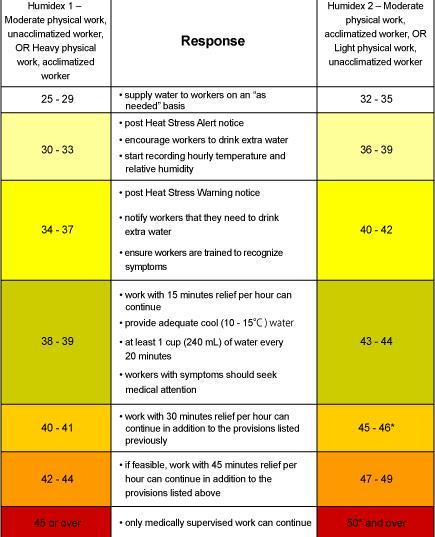
Page 5 of 9
TABLE 3High Winds (including thunderstorms, tornados, and hurricanes)
4.10 Environment and Climate Change Canada issues wind warnings when the wind is sustained at 70 km/h or more, and/or when there are gusts of 90 km/h or more.
4.11 Severe thunderstorm warnings are issued when one or more of the following conditions are met:
▪ There are wind gusts of 90 km/h or greater;
▪ Hail of 2 cm or larger in diameter; or
▪ Heavy rainfall.
4.12 Tornado warnings are issued when a tornado has been reported, or there’s evidence of one based on radar.
4.13 Hurricane warnings are issued when hurricane-force gales (sustained winds of 118 km/h or higher) caused by a hurricane, or a strong tropical storm are expected to occur within 24 hours or less.
4.14 When working in extremely high winds, the following guidelines should be followed:
▪ Stop work when it becomes too dangerous due to high winds;
▪ In the event of a storm surge due to high winds, avoid coastal areas;
▪ Secure loose items by bringing indoors or use weights, ropes, etc.;
▪ Secure latches, doors, windows, etc.;
▪ Be careful when carrying or lifting large objects such as plywood which can act like a sail;
▪ Be aware of objects and structures that move suddenly due to the wind;
▪ Take shelter and stay indoors. Stay away from outside walls and windows, if possible;
▪ If driving and unable to find shelter, stay in your vehicle. Move to an area where you will be less likely to get hit by falling trees or power lines if possible;
▪ Keep distance from high vehicles such as transport trucks and buses as strong wind gusts can flip these vehicles;
▪ Use buildings and vehicles to help block the wind;
▪ Wear fall protection and secure yourself properly if you are working at heights;
▪ Wear safety glasses/goggles when it’s appropriate;
▪ Avoid performing lifting operations, using cranes, or doing similar activities;
▪ If able, avoid working at heights when high winds are forecasted; and
▪ Do not reach at or try to grab an object that blows away.
4.15 Working aloft is when work is being performed at a height and involves risk of falling, resulting in an injury. When working aloft in an extreme weather event, the following guidelines should be followed:
▪ All work should stop when the weather conditions compromise the ability of the workers to safely complete a task. This includes safe operation of tools and equipment, and hazards that might affect the minimum approach distances for workers and/or equipment to energized lines;
▪ Operating aerial devices with sustained wind or gusts above 80km/h should be considered hazardous unless additional precautions are taken to protect workers and equipment;
▪ If conditions exist that compromise a worker’s ability to safely work aloft, the work should stop until the Incident Prevention Plan can be updated with all workers on site to mitigate hazards;
Page 6 of 9
▪ At any time when working aloft with high wind conditions that are considered hazardous, the decision to stop work should be made by the worker/workers on site;
▪ Two or more workers must be present for all work aloft in extreme wind conditions;
▪ If minimum approach distances cannot be maintained due to the wind, work must stop; and
▪ Maximum of one worker in the bucket at a time.
4.16 Lightning is various forms of visible electrical discharge that are produced by thunderstorms; often seen as a bright flash of light in the sky.
4.17 People that are struck by lightning do not carry an electrical charge and can therefore be handled safety. Victims may be suffering from burns or shock and should receive medical attention immediately.
4.18 When Environment and Climate Change Canada issues a thunderstorm warning, or if thunder can be heard, the following guidelines should be followed:
▪ Stop work and seek to take shelter immediately;
▪ If far from a shelter, stay away from tall objects such as trees, poles, and fences;
▪ When in a vehicle, stay inside and do not park under or around tall objects that could fall;
▪ Avoid being at the highest point in an open area;
▪ Stay away from water;
▪ Stay away from objects that conduct electricity, such as objects made of metal;
▪ Keep alert for flash floods when seeking shelter in a low-lying area;
▪ Do not go outside unless absolutely necessary; and
▪ Wait 30 minutes after the last rumble of thunder before going outside.
4.19 Environment and Climate Change Canada issues heavy rain warnings when 25 mm or more of rain is expected to fall within one hour within Atlantic Canada and northern provinces and territories or when 50 mm or more of rain expected to fall within one hour in other regions of Canada.
4.20 When working during heavy rain, the following guidelines should be followed:
▪ Reduce the pace of work; rain can cause surfaces, tools, and equipment to become slippery increasing the chances of slipping or dropping objects;
▪ Take extra care while working or driving as rain causes poor visibility; and
▪ Try to stay indoors to avoid getting hit by hail Hail can fall at a great speed, especially when accompanied by high winds
4.21 Environment and Climate Change Canada issues snowfall warnings when 15 cm or more of snow falls within 12 hours or less in Atlantic Canada, Quebec, Ontario, and regions of British Columbia or between 10 cm or 20 cm within other areas of Canada. Winter storm watches or warnings are issued when conditions are favourable for severe and potentially dangerous winter weather including:
• A blizzard;
• A major snowfall of 25 cm or more within 24 hours; and/or
• A significant snowfall combined with other winter weather hazards such as freezing rain, strong wind, blowing snow and/or extreme wind chill.
Page 7 of 9
4.22 The following guidelines should be taken during or after a snowstorm:
▪ Take extra care while driving. Snow and ice reduces tire traction and falling or blowing snow can decrease visibility; and
▪ Take extra time and use more caution when doing work if there is low visibility.
4.23 During winter storms where freezing rain is falling, the following guidelines should be followed:
▪ When outside pay attention to branches and powerlines that could break from the weight of the ice and fall Ice from freezing rain can accumulate on branches, power lines, and buildings;
▪ Stay alert after precipitation ends as ice, branches, and powerlines can continue to break for many hours after;
▪ Try to avoid driving when freezing rain is forecasted, roads can become very slippery from a very small amount of freezing rain; and
▪ Wear the proper clothing to stay warm as freezing rain mixed with high winds will increase the chances for hypothermia
4.24 Atmospheric pressure, or air pressure, is the force exerted on a surface by the air above it as gravity pulls it to Earth Most dangers associated with atmospheric pressure occur at low pressure at very high altitudes, which cannot be reached on Prince Edward Island.
4.25 High atmospheric pressure can cause blood pressure to rise and increase the possibility of heart attacks. Low atmospheric pressure can cause many symptoms such as headache, nausea, fatigue, dizziness, joint pain and shortening of breath. Rapid changes in atmospheric pressure can also induce headaches and migraines. Most people are not overly sensitive to small changes in atmospheric pressure.
4.26 The following guidelines should be used to help reduce symptoms if sensitive to changes in atmospheric pressure:
▪ Drink more water;
▪ Avoid foods and drinks that contain caffeine; and
▪ Try to manage stress through exercise, deep breathing, and relaxation techniques.
4.27 When working while there is low visibility such as darkness, fog, or rain, the following guidelines should be followed:
▪ Wear high-visibility safety apparel (“HVSA”) especially when working around moving vehicles;
▪ Make sure that your HVSA is clean and bright. Dirty or faded clothing loses their effectiveness; and
▪ Take extra time and use more caution when doing work and while driving. If needed, use the vehicle’s fog lights to help with visibility.
Owner Ken Sampson
Approver Enrique Riveroll
Date May 6, 2024
Date May 6, 2024
